
18 Immersive Photo Essay Examples & Tips
By Tata Rossi 13 days ago, Professional photography

A photo essay tells a story or evokes emotion through a series of photographs. The essays allow you to be creative and fully explore an idea. Such essays exist in a variety of forms – from photos only to images with brief comments or written essays accompanied by shots. Choose a photo essay example that you can easily do based on your professional level and the equipment you use.
1. Protests
- View the “Resistance” photo essay by David Moore .
A great idea for photo essays for students is to shoot the protest to show its power. You can capture people with signs and banners to demonstrate what they are standing for. Besides, you can learn how to capture moving subjects. Use the best example of photo essay and don’t forget about angles, composition, and framing.
To create a photo essay , go up to the front and photograph the leader of the protesters walking forward. After that, go back to the end of the group to take pictures of families joining the protest. As a result, you will gain experience shooting big groups of people in motion.
2. Transformation
- View the “A Self-Portrait Every Day” photo essay by Noah Kalina .
This idea is all about capturing the way a person changes. You may take photos of a pregnant woman and then capture the same model with a child. By documenting the development of the child for several years, you can tell a great story in the form of a photo essay.
However, you can also create a photo essay about the transformation of different objects. For instance, you can create a time-lapse series to capture the history of a renovated building. While you will have to take a lot of similar photos to bring this idea to life, it will allow you to achieve an impressive result.
3. Local Event
- View the “Monday Marathon” photo essay by Quinn G. Perini .
Whether you are a resident of a large city or a small town, you can find an opportunity to visit a local event, like a marathon or a festival. This is a nice chance to follow modern photography trends and bring photo essay ideas to life.
You can capture the before-and-after stages of the event. Arrive earlier and take pictures of the preparation activities, then shoot the actual event starting with the official beginning.
Keep photographing even when the event is over and capture the cleaning up and disassembling processes.
4. Photowalk
- View the “Empty Campus” photo essay by Elise Trissel .
Explore the location where you live and find interesting objects to capture in the vicinity. Using the most interesting photo essay examples, you can decide how to make the best decisions. Don’t hurry and try to discover which angles you can use to capture the unique atmosphere of each place.
If you live in the city, you may capture architectural details, wide shots of busy streets, or just take photos of passersby and street signs. Think about the details that make every location unique. For instance, you can try capturing reflections to see how they allow you to see the city from an unusual angle. You can find reflections everywhere, so be sure to pay attention to mirrored buildings, puddles, and fountains.
5. Place Over Time
- View the “At Home in the Ozarks” photo essay by Kylee Cole .
If you want to document changes and show how the streets, buildings, and parks in your city change over time, select your favorite locations and start to visit them regularly to capture the way they look during different seasons.
- View the “Last Moments” photo essay by Ross Taylor .
You don’t necessarily have to focus on profound photo essay topics to evoke emotions. Capturing pets enjoying their worry-free and untroubled life seems like an easy but interesting activity.
Choose any animal – from a domestic bird to a dog, cat, or horse. For more emotional images, use such pet photography ideas when your pet is still a baby and recreate these shots when it is older or is in its final days.
7. Street Style
- View the Tribal Street Photography photo essay by Hans Eijkelboom .
People often express themselves with the help of clothes. The way passers-by on the streets are dressed may reflect the clothing style of a whole society. That’s why you can travel around the world and capture people’s outfits in various areas. When taking portrait photos in the streets, you can also include some of the surroundings to put them in the context.
You can ask people in the streets to pose for you or try to capture them in movement. Select a suitable location for taking photos and create a photo essay to document what kinds of people one can meet in this location. When doing urban photography , you should ask people for permission before taking photos of them. You can ask their contacts and send them your photos later.
8. Abandoned Building
- View the “Lost Collective” photo essay by Bret Pattman .
Old buildings are excellent architecture photography essay topics for students since you can capture a large number of elements. They allow you to imagine what a particular street looked like in the past. You may use a photo essay example for students as references.
Get approval before going in, but mind that such places are far from being totally safe. Bring various lenses: the macro lenses – for details and the wide-angle one – when you want to include many elements in one shot.
9. Alternative Lifestyles
- View the “Last Nomad Hippies” photo essay by Roberto Palomo .
Some people decide to lead a lifestyle that differs from the one generally accepted by society. Explore different areas and look for people with an unusual way of living. You can capture candid photos of regular people or take pictures of a person with an unusual hobby.
Take pictures of those, who reside in extraordinary conditions, representatives of various subcultures, or the LBGTQ community. These photo essay topics show other people that it is okay to go out of their comfort zone and run against the wind.
10. Social Issues
- View the “Juveniles in Prison” photo essay by Isadora Kosofsky .
The best photo essay examples for students are related to social issues, like unemployment, domestic violence, gender discrimination, and more. Address the topic carefully and look for a proper perspective.
Your shots may draw the people’s attention to a truly burning and relevant matter and have a stronger effect than any text.
11. Behind the Scenes
- View the “Follow Me” photo essay by Marius Masalar .
If you are going to visit an event, get ready to take some behind-the-scenes photos. For instance, you can document the preparations for a festival. Capture the work of the lead event planner and other professionals to tell the story of the festival from an unusual angle.
Alternatively, you can capture the events happening backstage during a drama production. Take pictures of actors and actresses when they are getting ready for the performance. Try capturing the emotions of the main lead and show how stage workers make final preparations. You can also document the work of designers and makeup professionals.
12. Landmarks
- View the “Volte-Face” photo essay by Oliver Curtis .
The pictures of landmarks are typically taken from a certain spot. One of the best photo essay ideas is to try shooting sights from various angles. You will also have an opportunity to improve your composition and your framing skills.
If you take a look at any pictorial essay example, you will see that the variety of perspectives is endless: through the streets, in the morning, afternoon, and evening, with a drone or including reflections.
• View the “Family” photo essay by Olivia Moore .
You can capture the way family members interact with each other and demonstrate the strong connection they share. In some cases, it makes sense to focus on capturing candid photos when doing family photography .
However, you may also opt for a different approach and focus on more difficult social topics. For instance, if you want to examine the issue of immigration, you can take pictures of a family from another country. In addition, you may show how families cope with other social issues, including poverty or unequal access to healthcare.
14. A Day in the Life
- View the “A Day in the Life of Carlos Gaytan” photo essay by Sandy Noto .
One of the best photo essays concepts is related to a day in a person’s life. The main character can be any person – a relative, family member, teacher, writer, or policeman.
People are generally interested in finding out facts about the lives and daily routines of others. The life of every human is incredible, especially if you learn it in more detail. This idea is especially suitable for taking documentary photos. For instance, you can select any photo essay sample you like and then capture a portrait of a person with the tools they use for their work.
15. Education
- View the “School Day” photo essay by Nancy Borowick .
You can also take great photos in the classroom capturing the interactions of teachers and their students. Avoid distracting them, as it will be easier for you to take natural shots. Using a variety of settings, you can make your photo essay more engaging. For instance, you may visit chemistry labs, capture teachers during a break, and take photos in other locations.
- View the “Meals From the Motherland” photo essay by James Tran .
You can also focus on specific meals to create a professional photo essay about food. To make it more attention-grabbing, try using different food photography ideas .
For instance, you can take photos of popular meals, capture the meals made by a specific person, or document cooking traditions in different countries. When taking photos in a restaurant, pay attention to the surroundings as well to capture the unique atmosphere of a place.
17. Capture the Neighbors
- View the “Our Neighbors” photo essay by Jeanne Martin .
Regardless of the place where you live, you have to establish good relationships with your neighbors. People who live nearby can also be great models for professionals who specialize in portrait photography. To implement this idea, make sure to capture people at home or in front of their houses to include some of the surroundings in your photo essay.
You will discover many interesting facts about people who live nearby. Shooting a photo essay will allow you to learn them better and establish a strong connection with them. This way, you can create a sense of community and discover what holds its members together.
18. Climate Change
- View the “Effects of Climate Change” photo essay by Sanya Gupta .
It is possible to a variety of photo story ideas bring to life examining the impact of climate change. Travel to places most affected by climate change, for instance, glaciers or famous resorts.
Capture the way the continuous drought has influenced the environment, animals, and the inhabitants. As an alternative, take pictures of environmentalist protests or inexhaustible energy sources.
Photo Essay Tips for Students
Explore your topic . An in-depth exploration of the main topic of your photo essay will help you find the best ideas for conveying your message. You can also find some sources for inspiration and useful materials. This stage allows you to learn more about your subject and select the best way of organizing your photo essay.
Create a storyboard . Using a storyboard, you can better understand what shots you need to take and what order can help you to tell a story in the best way. It will also allow you to create the right mood.
Take as many pictures as you can . To create a compelling story, make sure to take a lot of photos. It will allow you to choose the best pictures for your photo essay. Besides, you will always have backup photos if some of your pictures get damaged.
Experiment with different techniques . By changing the angle and using a variety of editing techniques, you can transform the way your photos look. When taking photos, try using different angles to capture the subject in the best way. You can also try changing the distance from the model, using black-and-white film, or employing a range of developing methods.
Add text . While some photographers create photo essays without text, it can still help you bring your point across more clearly and make it easier for a viewer to understand what you imply. By providing extra information, such as some facts, you can change the perception of your image. If you don’t know how to write descriptions, you can hire a professional writer to perform this task.
Enhance your photos . To edit your pictures, make sure to use professional photo editing software like Adobe Lightroom or Photoshop. Using the available tools, you can improve and change your photos. They allow you to fix issues with lighting, adjust WB, make colors richer, crop your pics to improve the composition, and perform other tasks. In case you need to edit your photos in a consistent style, you can use Photoshop Actions or Lightroom Presets.
In some cases, your pictures may require more advanced editing. If you see that your skills are insufficient or if you don’t have enough time, you can outsource the task of enhancing your photos to the FixThePhoto team. They will professionally enhance your pictures for a budget price. Their prices start from $1.50 per photo.
Want to Get a Professionally-Retouched Photo Essay?
The editing team at FixThePhoto specializes in delivering personalized and artistically enhanced photo essay, making sure to meet all your preferences. They can assist with different tasks, whether it's selecting the best shots or doing detailed retouching work.
Bonus Tools
To streamline your workflow and quickly edit your essay photos like a pro, make sure to apply these actions to your photos. Even if you use a photo essay example when taking pictures, you can utilize these actions to give your images a professional feel, tweak colors, edit lighting, and improve the overall look of your pics.
In this bundle, you will find actions created by experienced professionals who used recent photo enhancement trends to create convenient editing tools. Here, you will find a collection of brushes, patterns, overlays, and other effects for editing your photos in a realistic way.
- Photo essay examples
- Photo essay tips
- Bonus tools

- Video Editing Services
- Virtual Staging Services
- Outsource Photo Editing
- Retouching Tips
- Photo Editing Freebies
- Free Raw Images for Retouching
- Free Photoshop Actions
- Free Lightroom Presets
- Affiliate Program
- Privacy Policy
- Cookie Policy

The leading authority in photography and camera gear.
Become a better photographer.
12.9 Million
Annual Readers
Newsletter Subscribers
Featured Photographers
Photography Guides & Gear Reviews

How to Create an Engaging Photo Essay (with Examples)
Photo essays tell a story in pictures. They're a great way to improve at photography and story-telling skills at once. Learn how to do create a great one.
Learn | Photography Guides | By Ana Mireles
Photography is a medium used to tell stories – sometimes they are told in one picture, sometimes you need a whole series. Those series can be photo essays.
If you’ve never done a photo essay before, or you’re simply struggling to find your next project, this article will be of help. I’ll be showing you what a photo essay is and how to go about doing one.
You’ll also find plenty of photo essay ideas and some famous photo essay examples from recent times that will serve you as inspiration.
If you’re ready to get started, let’s jump right in!
Table of Contents
What is a Photo Essay?
A photo essay is a series of images that share an overarching theme as well as a visual and technical coherence to tell a story. Some people refer to a photo essay as a photo series or a photo story – this often happens in photography competitions.
Photographic history is full of famous photo essays. Think about The Great Depression by Dorothea Lange, Like Brother Like Sister by Wolfgang Tillmans, Gandhi’s funeral by Henri Cartier Bresson, amongst others.
What are the types of photo essay?
Despite popular belief, the type of photo essay doesn’t depend on the type of photography that you do – in other words, journalism, documentary, fine art, or any other photographic genre is not a type of photo essay.
Instead, there are two main types of photo essays: narrative and thematic .
As you have probably already guessed, the thematic one presents images pulled together by a topic – for example, global warming. The images can be about animals and nature as well as natural disasters devastating cities. They can happen all over the world or in the same location, and they can be captured in different moments in time – there’s a lot of flexibility.
A narrative photo essa y, on the other hand, tells the story of a character (human or not), portraying a place or an event. For example, a narrative photo essay on coffee would document the process from the planting and harvesting – to the roasting and grinding until it reaches your morning cup.
What are some of the key elements of a photo essay?
- Tell a unique story – A unique story doesn’t mean that you have to photograph something that nobody has done before – that would be almost impossible! It means that you should consider what you’re bringing to the table on a particular topic.
- Put yourself into the work – One of the best ways to make a compelling photo essay is by adding your point of view, which can only be done with your life experiences and the way you see the world.
- Add depth to the concept – The best photo essays are the ones that go past the obvious and dig deeper in the story, going behind the scenes, or examining a day in the life of the subject matter – that’s what pulls in the spectator.
- Nail the technique – Even if the concept and the story are the most important part of a photo essay, it won’t have the same success if it’s poorly executed.
- Build a structure – A photo essay is about telling a thought-provoking story – so, think about it in a narrative way. Which images are going to introduce the topic? Which ones represent a climax? How is it going to end – how do you want the viewer to feel after seeing your photo series?
- Make strong choices – If you really want to convey an emotion and a unique point of view, you’re going to need to make some hard decisions. Which light are you using? Which lens? How many images will there be in the series? etc., and most importantly for a great photo essay is the why behind those choices.
9 Tips for Creating a Photo Essay

Credit: Laura James
1. Choose something you know
To make a good photo essay, you don’t need to travel to an exotic location or document a civil war – I mean, it’s great if you can, but you can start close to home.
Depending on the type of photography you do and the topic you’re looking for in your photographic essay, you can photograph a local event or visit an abandoned building outside your town.
It will be much easier for you to find a unique perspective and tell a better story if you’re already familiar with the subject. Also, consider that you might have to return a few times to the same location to get all the photos you need.
2. Follow your passion
Most photo essays take dedication and passion. If you choose a subject that might be easy, but you’re not really into it – the results won’t be as exciting. Taking photos will always be easier and more fun if you’re covering something you’re passionate about.
3. Take your time
A great photo essay is not done in a few hours. You need to put in the time to research it, conceptualizing it, editing, etc. That’s why I previously recommended following your passion because it takes a lot of dedication, and if you’re not passionate about it – it’s difficult to push through.
4. Write a summary or statement
Photo essays are always accompanied by some text. You can do this in the form of an introduction, write captions for each photo or write it as a conclusion. That’s up to you and how you want to present the work.
5. Learn from the masters
How Much Do You REALLY Know About Photography?! 🤔
Test your photography knowledge with this quick quiz!
See how much you really know about photography...

Your answer:
Correct answer:
SHARE YOUR RESULTS
Your Answers
Making a photographic essay takes a lot of practice and knowledge. A great way to become a better photographer and improve your storytelling skills is by studying the work of others. You can go to art shows, review books and magazines and look at the winners in photo contests – most of the time, there’s a category for photo series.
6. Get a wide variety of photos
Think about a story – a literary one. It usually tells you where the story is happening, who is the main character, and it gives you a few details to make you engage with it, right?
The same thing happens with a visual story in a photo essay – you can do some wide-angle shots to establish the scenes and some close-ups to show the details. Make a shot list to ensure you cover all the different angles.
Some of your pictures should guide the viewer in, while others are more climatic and regard the experience they are taking out of your photos.
7. Follow a consistent look
Both in style and aesthetics, all the images in your series need to be coherent. You can achieve this in different ways, from the choice of lighting, the mood, the post-processing, etc.
8. Be self-critical
Once you have all the photos, make sure you edit them with a good dose of self-criticism. Not all the pictures that you took belong in the photo essay. Choose only the best ones and make sure they tell the full story.
9. Ask for constructive feedback
Often, when we’re working on a photo essay project for a long time, everything makes perfect sense in our heads. However, someone outside the project might not be getting the idea. It’s important that you get honest and constructive criticism to improve your photography.
How to Create a Photo Essay in 5 Steps

Credit: Quang Nguyen Vinh
1. Choose your topic
This is the first step that you need to take to decide if your photo essay is going to be narrative or thematic. Then, choose what is it going to be about?
Ideally, it should be something that you’re interested in, that you have something to say about it, and it can connect with other people.
2. Research your topic
To tell a good story about something, you need to be familiar with that something. This is especially true when you want to go deeper and make a compelling photo essay. Day in the life photo essays are a popular choice, since often, these can be performed with friends and family, whom you already should know well.
3. Plan your photoshoot
Depending on what you’re photographing, this step can be very different from one project to the next. For a fine art project, you might need to find a location, props, models, a shot list, etc., while a documentary photo essay is about planning the best time to do the photos, what gear to bring with you, finding a local guide, etc.
Every photo essay will need different planning, so before taking pictures, put in the required time to get things right.
4. Experiment
It’s one thing to plan your photo shoot and having a shot list that you have to get, or else the photo essay won’t be complete. It’s another thing to miss out on some amazing photo opportunities that you couldn’t foresee.
So, be prepared but also stay open-minded and experiment with different settings, different perspectives, etc.
5. Make a final selection
Editing your work can be one of the hardest parts of doing a photo essay. Sometimes we can be overly critical, and others, we get attached to bad photos because we put a lot of effort into them or we had a great time doing them.
Try to be as objective as possible, don’t be afraid to ask for opinions and make various revisions before settling down on a final cut.
7 Photo Essay Topics, Ideas & Examples

Credit: Michelle Leman
- Architectural photo essay
Using architecture as your main subject, there are tons of photo essay ideas that you can do. For some inspiration, you can check out the work of Francisco Marin – who was trained as an architect and then turned to photography to “explore a different way to perceive things”.
You can also lookup Luisa Lambri. Amongst her series, you’ll find many photo essay examples in which architecture is the subject she uses to explore the relationship between photography and space.
- Process and transformation photo essay
This is one of the best photo essay topics for beginners because the story tells itself. Pick something that has a beginning and an end, for example, pregnancy, the metamorphosis of a butterfly, the life-cycle of a plant, etc.
Keep in mind that these topics are linear and give you an easy way into the narrative flow – however, it might be difficult to find an interesting perspective and a unique point of view.
- A day in the life of ‘X’ photo essay
There are tons of interesting photo essay ideas in this category – you can follow around a celebrity, a worker, your child, etc. You don’t even have to do it about a human subject – think about doing a photo essay about a day in the life of a racing horse, for example – find something that’s interesting for you.
- Time passing by photo essay
It can be a natural site or a landmark photo essay – whatever is close to you will work best as you’ll need to come back multiple times to capture time passing by. For example, how this place changes throughout the seasons or maybe even over the years.
A fun option if you live with family is to document a birthday party each year, seeing how the subject changes over time. This can be combined with a transformation essay or sorts, documenting the changes in interpersonal relationships over time.
- Travel photo essay
Do you want to make the jump from tourist snapshots into a travel photo essay? Research the place you’re going to be travelling to. Then, choose a topic.
If you’re having trouble with how to do this, check out any travel magazine – National Geographic, for example. They won’t do a generic article about Texas – they do an article about the beach life on the Texas Gulf Coast and another one about the diverse flavors of Texas.
The more specific you get, the deeper you can go with the story.
- Socio-political issues photo essay
This is one of the most popular photo essay examples – it falls under the category of photojournalism or documental photography. They are usually thematic, although it’s also possible to do a narrative one.
Depending on your topic of interest, you can choose topics that involve nature – for example, document the effects of global warming. Another idea is to photograph protests or make an education photo essay.
It doesn’t have to be a big global issue; you can choose something specific to your community – are there too many stray dogs? Make a photo essay about a local animal shelter. The topics are endless.
- Behind the scenes photo essay
A behind-the-scenes always make for a good photo story – people are curious to know what happens and how everything comes together before a show.
Depending on your own interests, this can be a photo essay about a fashion show, a theatre play, a concert, and so on. You’ll probably need to get some permissions, though, not only to shoot but also to showcase or publish those images.
4 Best Photo Essays in Recent times
Now that you know all the techniques about it, it might be helpful to look at some photo essay examples to see how you can put the concept into practice. Here are some famous photo essays from recent times to give you some inspiration.
Habibi by Antonio Faccilongo
This photo essay wan the World Press Photo Story of the Year in 2021. Faccilongo explores a very big conflict from a very specific and intimate point of view – how the Israeli-Palestinian war affects the families.
He chose to use a square format because it allows him to give order to things and eliminate unnecessary elements in his pictures.
With this long-term photo essay, he wanted to highlight the sense of absence and melancholy women and families feel towards their husbands away at war.
The project then became a book edited by Sarah Leen and the graphics of Ramon Pez.

Picture This: New Orleans by Mary Ellen Mark
The last assignment before her passing, Mary Ellen Mark travelled to New Orleans to register the city after a decade after Hurricane Katrina.
The images of the project “bring to life the rebirth and resilience of the people at the heart of this tale”, – says CNNMoney, commissioner of the work.
Each survivor of the hurricane has a story, and Mary Ellen Mark was there to record it. Some of them have heartbreaking stories about everything they had to leave behind.
Others have a story of hope – like Sam and Ben, two eight-year-olds born from frozen embryos kept in a hospital that lost power supply during the hurricane, yet they managed to survive.

Selfie by Cindy Sherman
Cindy Sherman is an American photographer whose work is mainly done through self-portraits. With them, she explores the concept of identity, gender stereotypes, as well as visual and cultural codes.
One of her latest photo essays was a collaboration with W Magazine entitled Selfie. In it, the author explores the concept of planned candid photos (‘plandid’).
The work was made for Instagram, as the platform is well known for the conflict between the ‘real self’ and the one people present online. Sherman started using Facetune, Perfect365 and YouCam to alter her appearance on selfies – in Photoshop, you can modify everything, but these apps were designed specifically to “make things prettier”- she says, and that’s what she wants to explore in this photo essay.
Tokyo Compression by Michael Wolf
Michael Wolf has an interest in the broad-gauge topic Life in Cities. From there, many photo essays have been derived – amongst them – Tokyo Compression .
He was horrified by the way people in Tokyo are forced to move to the suburbs because of the high prices of the city. Therefore, they are required to make long commutes facing 1,5 hours of train to start their 8+ hour workday followed by another 1,5 hours to get back home.
To portray this way of life, he photographed the people inside the train pressed against the windows looking exhausted, angry or simply absent due to this way of life.
You can visit his website to see other photo essays that revolve around the topic of life in megacities.
Final Words
It’s not easy to make photo essays, so don’t expect to be great at it right from your first project.
Start off small by choosing a specific subject that’s interesting to you – that will come from an honest place, and it will be a great practice for some bigger projects along the line.
Whether you like to shoot still life or you’re a travel photographer, I hope these photo essay tips and photo essay examples can help you get started and grow in your photography.
Let us know which topics you are working on right now – we’ll love to hear from you!

Check out these 8 essential tools to help you succeed as a professional photographer.
Includes limited-time discounts.
You'll Also Like These:

Ana Mireles is a Mexican researcher that specializes in photography and communications for the arts and culture sector.
Penelope G. To Ana Mireles Such a well written and helpful article for an writer who wants to inclue photo essay in her memoir. Thank you. I will get to work on this new skill. Penelope G.
Herman Krieger Photo essays in black and white
Leave a Comment Cancel Reply
👋 WELCOME TO SHOTKIT!

🔥 Popular NOW:

Unlock the EXACT blueprint to capture breathtaking iPhone photos!
Shotkit may earn a commission on affiliate links. Learn more.
- Share your Views
- Submit a Contest
- Recommend Contest
- Terms of Service
- Testimonials

Photo Contests – Photography competitions
- Filter Photo Contests
- All Photo Contests
- Get FREE Contests Updates
- Photo Contest Tips
- Photography Deals

What is a Photo Essay? 9 Photo Essay Examples You Can Recreate
A photo essay is a series of photographs that tell a story. Unlike a written essay, a photo essay focuses on visuals instead of words. With a photo essay, you can stretch your creative limits and explore new ways to connect with your audience. Whatever your photography skill level, you can recreate your own fun and creative photo essay.
9 Photo Essay Examples You Can Recreate
- Photowalk Photo Essay
- Transformation Photo Essay
- Day in the Life Photo Essay
- Event Photo Essay
- Building Photo Essay
- Historic Site or Landmark Photo Essay
- Behind the Scenes Photo Essay
- Family Photo Essay
- Education Photo Essay
Stories are important to all of us. While some people gravitate to written stories, others are much more attuned to visual imagery. With a photo essay, you can tell a story without writing a word. Your use of composition, contrast, color, and perspective in photography will convey ideas and evoke emotions.
To explore narrative photography, you can use basic photographic equipment. You can buy a camera or even use your smartphone to get started. While lighting, lenses, and post-processing software can enhance your photos, they aren’t necessary to achieve good results.
Whether you need to complete a photo essay assignment or want to pursue one for fun or professional purposes, you can use these photo essay ideas for your photography inspiration . Once you know the answer to “what is a photo essay?” and find out how fun it is to create one, you’ll likely be motivated to continue your forays into photographic storytelling.
1 . Photowalk Photo Essay
One popular photo essay example is a photowalk. Simply put, a photowalk is time you set aside to walk around a city, town, or a natural site and take photos. Some cities even have photowalk tours led by professional photographers. On these tours, you can learn the basics about how to operate your camera, practice photography composition techniques, and understand how to look for unique shots that help tell your story.
Set aside at least two to three hours for your photowalk. Even if you’re photographing a familiar place—like your own home town—try to look at it through new eyes. Imagine yourself as a first-time visitor or pretend you’re trying to educate a tourist about the area.
Walk around slowly and look for different ways to capture the mood and energy of your location. If you’re in a city, capture wide shots of streets, close-ups of interesting features on buildings, street signs, and candid shots of people. Look for small details that give the city character and life. And try some new concepts—like reflection picture ideas—by looking for opportunities to photographs reflections in mirrored buildings, puddles, fountains, or bodies of water.
2 . Transformation Photo Essay
With a transformation photography essay, you can tell the story about change over time. One of the most popular photostory examples, a transformation essay can document a mom-to-be’s pregnancy or a child’s growth from infancy into the toddler years. But people don’t need to be the focus of a transformation essay. You can take photos of a house that is being built or an urban area undergoing revitalization.
You can also create a photo narrative to document a short-term change. Maybe you want to capture images of your growing garden or your move from one home to another. These examples of photo essays are powerful ways of telling the story of life’s changes—both large and small.
3 . Day in the Life Photo Essay
Want a unique way to tell a person’s story? Or, perhaps you want to introduce people to a career or activity. You may want to consider a day in the life essay.
With this photostory example, your narrative focuses on a specific subject for an entire day. For example, if you are photographing a farmer, you’ll want to arrive early in the morning and shadow the farmer as he or she performs daily tasks. Capture a mix of candid shots of the farmer at work and add landscapes and still life of equipment for added context. And if you are at a farm, don’t forget to get a few shots of the animals for added character, charm, or even a dose of humor. These types of photography essay examples are great practice if you are considering pursuing photojournalism. They also help you learn and improve your candid portrait skills.
4 . Event Photo Essay
Events are happening in your local area all the time, and they can make great photo essays. With a little research, you can quickly find many events that you could photograph. There may be bake sales, fundraisers, concerts, art shows, farm markets, block parties, and other non profit event ideas . You could also focus on a personal event, such as a birthday or graduation.
At most events, your primary emphasis will be on capturing candid photos of people in action. You can also capture backgrounds or objects to set the scene. For example, at a birthday party, you’ll want to take photos of the cake and presents.
For a local or community event, you can share your photos with the event organizer. Or, you may be able to post them on social media and tag the event sponsor. This is a great way to gain recognition and build your reputation as a talented photographer.
5. Building Photo Essay
Many buildings can be a compelling subject for a photographic essay. Always make sure that you have permission to enter and photograph the building. Once you do, look for interesting shots and angles that convey the personality, purpose, and history of the building. You may also be able to photograph the comings and goings of people that visit or work in the building during the day.
Some photographers love to explore and photograph abandoned buildings. With these types of photos, you can provide a window into the past. Definitely make sure you gain permission before entering an abandoned building and take caution since some can have unsafe elements and structures.
6. Historic Site or Landmark Photo Essay
Taking a series of photos of a historic site or landmark can be a great experience. You can learn to capture the same site from different angles to help portray its character and tell its story. And you can also photograph how people visit and engage with the site or landmark. Take photos at different times of day and in varied lighting to capture all its nuances and moods.
You can also use your photographic essay to help your audience understand the history of your chosen location. For example, if you want to provide perspective on the Civil War, a visit to a battleground can be meaningful. You can also visit a site when reenactors are present to share insight on how life used to be in days gone by.
7 . Behind the Scenes Photo Essay
Another fun essay idea is taking photos “behind the scenes” at an event. Maybe you can chronicle all the work that goes into a holiday festival from the early morning set-up to the late-night teardown. Think of the lead event planner as the main character of your story and build the story about him or her.
Or, you can go backstage at a drama production. Capture photos of actors and actresses as they transform their looks with costuming and makeup. Show the lead nervously pacing in the wings before taking center stage. Focus the work of stagehands, lighting designers, and makeup artists who never see the spotlight but bring a vital role in bringing the play to life.
8. Family Photo Essay
If you enjoy photographing people, why not explore photo story ideas about families and relationships? You can focus on interactions between two family members—such as a father and a daughter—or convey a message about a family as a whole.
Sometimes these type of photo essays can be all about the fun and joy of living in a close-knit family. But sometimes they can be powerful portraits of challenging social topics. Images of a family from another country can be a meaningful photo essay on immigration. You could also create a photo essay on depression by capturing families who are coping with one member’s illness.
For these projects on difficult topics, you may want to compose a photo essay with captions. These captions can feature quotes from family members or document your own observations. Although approaching hard topics isn’t easy, these types of photos can have lasting impact and value.
9. Education Photo Essay
Opportunities for education photo essays are everywhere—from small preschools to community colleges and universities. You can seek permission to take photos at public or private schools or even focus on alternative educational paths, like homeschooling.
Your education photo essay can take many forms. For example, you can design a photo essay of an experienced teacher at a high school. Take photos of him or her in action in the classroom, show quiet moments grading papers, and capture a shared laugh between colleagues in the teacher’s lounge.
Alternatively, you can focus on a specific subject—such as science and technology. Or aim to portray a specific grade level, document activities club or sport, or portray the social environment. A photo essay on food choices in the cafeteria can be thought-provoking or even funny. There are many potential directions to pursue and many great essay examples.
While education is an excellent topic for a photo essay for students, education can be a great source of inspiration for any photographer.
Why Should You Create a Photo Essay?
Ultimately, photographers are storytellers. Think of what a photographer does during a typical photo shoot. He or she will take a series of photos that helps convey the essence of the subject—whether that is a person, location, or inanimate object. For example, a family portrait session tells the story of a family—who they are, their personalities, and the closeness of their relationship.
Learning how to make a photo essay can help you become a better storyteller—and a better photographer. You’ll cultivate key photography skills that you can carry with you no matter where your photography journey leads.
If you simply want to document life’s moments on social media, you may find that a single picture doesn’t always tell the full story. Reviewing photo essay examples and experimenting with your own essay ideas can help you choose meaningful collections of photos to share with friends and family online.
Learning how to create photo essays can also help you work towards professional photography ambitions. You’ll often find that bloggers tell photographic stories. For example, think of cooking blogs that show you each step in making a recipe. Photo essays are also a mainstay of journalism. You’ll often find photo essays examples in many media outlets—everywhere from national magazines to local community newspapers. And the best travel photographers on Instagram tell great stories with their photos, too.
With a photo essay, you can explore many moods and emotions. Some of the best photo essays tell serious stories, but some are humorous, and others aim to evoke action.
You can raise awareness with a photo essay on racism or a photo essay on poverty. A photo essay on bullying can help change the social climate for students at a school. Or, you can document a fun day at the beach or an amusement park. You have control of the themes, photographic elements, and the story you want to tell.
5 Steps to Create a Photo Essay
Every photo essay will be different, but you can use a standard process. Following these five steps will guide you through every phase of your photo essay project—from brainstorming creative essay topics to creating a photo essay to share with others.
Step 1: Choose Your Photo Essay Topics
Just about any topic you can imagine can form the foundation for a photo essay. You may choose to focus on a specific event, such as a wedding, performance, or festival. Or you may want to cover a topic over a set span of time, such as documenting a child’s first year. You could also focus on a city or natural area across the seasons to tell a story of changing activities or landscapes.
Since the best photo essays convey meaning and emotion, choose a topic of interest. Your passion for the subject matter will shine through each photograph and touch your viewer’s hearts and minds.
Step 2: Conduct Upfront Research
Much of the work in a good-quality photo essay begins before you take your first photo. It’s always a good idea to do some research on your planned topic.
Imagine you’re going to take photos of a downtown area throughout the year. You should spend some time learning the history of the area. Talk with local residents and business owners and find out about planned events. With these insights, you’ll be able to plan ahead and be prepared to take photos that reflect the area’s unique personality and lifestyles.
For any topic you choose, gather information first. This may involve internet searches, library research, interviews, or spending time observing your subject.
Step 3: Storyboard Your Ideas
After you have done some research and have a good sense of the story you want to tell, you can create a storyboard. With a storyboard, you can write or sketch out the ideal pictures you want to capture to convey your message.
You can turn your storyboard into a “shot list” that you can bring with you on site. A shot list can be especially helpful when you are at a one-time event and want to capture specific shots for your photo essay. If you’ve never created a photo essay before, start with ten shot ideas. Think of each shot as a sentence in your story. And aim to make each shot evoke specific ideas or emotions.
Step 4: Capture Images
Your storyboard and shot list will be important guides to help you make the most of each shoot. Be sure to set aside enough time to capture all the shots you need—especially if you are photographing a one-time event. And allow yourself to explore your ideas using different photography composition, perspective, and color contrast techniques.
You may need to take a hundred images or more to get ten perfect ones for your photographic essay. Or, you may find that you want to add more photos to your story and expand your picture essay concept.
Also, remember to look for special unplanned, moments that help tell your story. Sometimes, spontaneous photos that aren’t on your shot list can be full of meaning. A mix of planning and flexibility almost always yields the best results.
Step 5: Edit and Organize Photos to Tell Your Story
After capturing your images, you can work on compiling your photo story. To create your photo essay, you will need to make decisions about which images portray your themes and messages. At times, this can mean setting aside beautiful images that aren’t a perfect fit. You can use your shot list and storyboard as a guide but be open to including photos that weren’t in your original plans.
You may want to use photo editing software—such as Adobe Lightroom or Photoshop— to enhance and change photographs. With these tools, you can adjust lighting and white balance, perform color corrections, crop, or perform other edits. If you have a signature photo editing style, you may want to use Photoshop Actions or Lightroom Presets to give all your photos a consistent look and feel.
You order a photo book from one of the best photo printing websites to publish your photo story. You can add them to an album on a photo sharing site, such as Flickr or Google Photos. Also, you could focus on building a website dedicated to documenting your concepts through visual photo essays. If so, you may want to use SEO for photographers to improve your website’s ranking in search engine results. You could even publish your photo essay on social media. Another thing to consider is whether you want to include text captures or simply tell your story through photographs.
Choose the medium that feels like the best space to share your photo essay ideas and vision with your audiences. You should think of your photo essay as your own personal form of art and expression when deciding where and how to publish it.
Photo Essays Can Help You Become a Better Photographer
Whatever your photography ambitions may be, learning to take a photo essay can help you grow. Even simple essay topics can help you gain skills and stretch your photographic limits. With a photo essay, you start to think about how a series of photographs work together to tell a complete story. You’ll consider how different shots work together, explore options for perspective and composition, and change the way you look at the world.
Before you start taking photos, you should review photo essay examples. You can find interesting pictures to analyze and photo story examples online, in books, or in classic publications, like Life Magazine . Don’t forget to look at news websites for photojournalism examples to broaden your perspective. This review process will help you in brainstorming simple essay topics for your first photo story and give you ideas for the future as well.
Ideas and inspiration for photo essay topics are everywhere. You can visit a park or go out into your own backyard to pursue a photo essay on nature. Or, you can focus on the day in the life of someone you admire with a photo essay of a teacher, fireman, or community leader. Buildings, events, families, and landmarks are all great subjects for concept essay topics. If you are feeling stuck coming up with ideas for essays, just set aside a few hours to walk around your city or town and take photos. This type of photowalk can be a great source of material.
You’ll soon find that advanced planning is critical to your success. Brainstorming topics, conducting research, creating a storyboard, and outlining a shot list can help ensure you capture the photos you need to tell your story. After you’ve finished shooting, you’ll need to decide where to house your photo essay. You may need to come up with photo album title ideas, write captions, and choose the best medium and layout.
Without question, creating a photo essay can be a valuable experience for any photographer. That’s true whether you’re an amateur completing a high school assignment or a pro looking to hone new skills. You can start small with an essay on a subject you know well and then move into conquering difficult ideas. Maybe you’ll want to create a photo essay on mental illness or a photo essay on climate change. Or maybe there’s another cause that is close to your heart.
Whatever your passion, you can bring it to life with a photo essay.
JOIN OVER 82,545 and receive weekly updates!
Comments are closed.

Photo Contest Insider
The world’s largest collection of photo contests.
Photo contests are manually reviewed by our team to ensure only the very best make it on to our website. It’s our policy to only list photo contests that are fair.

Subscription
Register now to get updates on promotions and offers
DISCLAIMER:
- Photo Contest Filter
- Get FREE Contest Updates
Photo Contest Insider © 2009 - 2024
Advertise Submit Badges Help Terms Privacy Unsubscribe Do Not Sell My Information
Student Sign In

How to Create a Photo Essay in 9 Steps (with Examples)
Photo Editing , Tutorials

This post contains affiliate links. If you use these links to buy something, we may earn a commission at no additional cost to you. We only recommend products we fully support or use ourselves. Our full disclaimer
What is a photo essay?
- Photo essays vs photo stories
- How photo essays help you
- 9 Steps to create photo essays
How to share your photo essays
Read Time: 11 minutes
Gather up a handful of images that seem to go together, and voila! It’s a photo essay, right? Well… no. Though, this is a common misconception.
In reality, a photo essay is much more thoughtful and structured than that. When you take the time to craft one, you’re using skills from all facets of our craft – from composition to curation.
In this guide, you’ll learn what makes a photo essay an amazing project that stretches your skills. You'll also learn exactly how to make one step by step.
- Photo essay vs photo story
A photo essay is a collection of images based around a theme, a topic, a creative approach, or an exploration of an idea. Photo essays balance visual variety with a cohesive style and concept.
What's the difference between a photo essay and a photo story?
The terms photo essay and photo story are often used interchangeably. Even the dictionary definition of “photo essay” includes using images to convey either a theme or a story.
But in my experience, a photo essay and a photo story are two different things. As you delve into the field of visual storytelling, distinguishing between the two helps you to take a purposeful approach to what you’re making .
The differences ultimately lie in the distinctions between theme, topic and story.
Themes are big-picture concepts. Example: Wildness
Topics are more specific than themes, but still overarching. Example : Wild bears of Yellowstone National Park
Stories are specific instances or experiences that happen within, or provide an example for, a topic or theme. Example: A certain wild bear became habituated to tourists and was relocated to maintain its wildness
Unlike a theme or topic, a story has particular elements that make it a story. They include leading characters, a setting, a narrative arc, conflict, and (usually) resolution.
With that in mind, we can distingush between a photo essay and a photo story.
Themes and Topics vs Stories
A photo essay revolves around a topic, theme, idea, or concept. It visually explores a big-picture something .
This allows a good deal of artistic leeway where a photographer can express their vision, philosophies, opinions, or artistic expression as they create their images.
A photo story is a portfolio of images that illustrate – you guessed it – a story.
Because of this, there are distinct types of images that a photo story uses that add to the understanding, insight, clarity and meaning to the story for viewers. While they can certainly be artistically crafted and visually stunning, photo stories document something happening, and rely on visual variety for capturing the full experience.
A photo essay doesn’t need to have the same level of structured variety that a photo story requires. It can have images that overlap or are similar, as they each explore various aspects of a theme.

Photo essays can be about any topic. If you live in a city, consider using your nature photography to make an essay about the wildlife that lives in your neighborhood .
The role of text with photos
A photo story typically runs alongside text that narrates the story. We're a visual species, and the images help us feel like we are there, experiencing what's happening. So, the images add significant power to the text, but they're often a partner to it.
This isn’t always the case, of course. Sometimes photo stories don’t need or use text. It’s like reading a graphic novel that doesn’t use text. Moving through the different images that build on each other ultimately unveils the narrative.
Photo essays don’t need to rely on text to illuminate the images' theme or topic. The photographer may use captions (or even a text essay), or they may let the images speak for themselves.
Definitions are helpful guidelines (not strict rules)
Some people categorize photo essays as either narrative or thematic. That's essentially just calling photo stories “narrative photo essays” and photo essays “thematic photo essays.”
But, a story is a defined thing, and any writer/editor will tell you themes and topics are not the same as stories. And we use the word “story” in our daily lives as it’s defined. So, it makes far more sense to name the difference between a photo essay and a photo story, and bask in the same clarity writers enjoy .
Photo stories illustrate a particular experience, event, narrative, something that happened or is happening.
Photo essays explore an idea, concept, topic, theme, creative approach, big-picture something .
Both photo essays and photo stories are immensely powerful visual tools. And yes, the differences between them can certainly be blurred, as is always the case with art.
Simply use this distinction as a general guideline, providing extra clarity around what you’re making and why you're making it.
To dig into specific types of images used to create powerful photo stories, check out this training: 6 Must-Have Shots for a Photo Story.
Meanwhile, let’s dig deeper into photo essays.

Photo essays are a chance to try new styles or techniques that stretch your skills and creativity. This image was part of an essay exploring simplicity and shape, and helped me learn new skills in black and white post-processing.
How photo essays improve your photography
Creating photo essays is an amazing antidote if you’ve ever felt a lack of direction or purpose in your photography. Photo essays help build your photographic skills in at least 3 important ways.
1. You become more strategic in creating a body of work
It's easy to get stuck in a rut of photographing whatever pops up in front of you. And when you do, you end up with a collection of stand-alone shots.
These singles may work fine as a print, a quick Instagram post, or an addition to your gallery of shots on your website. But amassing a bunch of one-off shots limits your opportunities as a photographer for everything from exhibits to getting your work published.
Building photo essays pushes you to think strategically about what you photograph, why, and how. You're working toward a particular deliverable – a cohesive visual essay – with the images you create.
This elevates your skills in crafting your photo essay, and in how you curate the rest of your work, from galleries on your website to selecting images to sell as prints .
2. You become more purposeful in your composition skills
Composition is so much more than just following the rule of thirds, golden spirals, or thinking about the angle of light in a shot.
Composition is also about thinking ahead in what you’re trying to accomplish with a photograph – from what you’re saying through it to its emotional impact on a viewer – and where it fits within a larger body of work.
Photo essays push you to think critically about each shot – from coming up with fresh compositions for familiar subjects, to devising surprising compositions to fit within a collection, to creating compositions that expand on what’s already in a photo essay.
You’re pushed beyond creating a single pleasing frame, which leads you to shoot more thoughtfully and proactively than ever.
(Here’s a podcast episode on switching from reactive shooting to proactive shooting.)
3. You develop strong editing and curation skills
Selecting which images stay, and which get left behind is one of the hardest jobs on a photographer’s to-do list. Mostly, it’s because of emotional attachment.
You might think it’s an amazing shot because you know the effort that went into capturing it. Or perhaps when you look at it, you get a twinge of the joy or exhilaration you felt the moment you captured it. There’s also the second-guessing that goes into which of two similar images is the best – which will people like more? So you’re tempted to just show both.
Ultimately, great photographers appear all the more skilled because they only show their best work. That in and of itself is a skill they’ve developed through years of ruthlessly editing their own work.
Because the most powerful photo essays only show a handful of extraordinary images, you’re bound to develop the very same critical skill (and look all the more talented because of it).
Photo essays are also a great stepping stone to creating photo stories. If you’re interested in moving beyond stand-alone shots and building stories, shooting photo essays will get your creative brain limbered up and ready for the adventure of photo stories.

A photo essay exploring the natural history of a favorite species is an exciting opportunity for an in-depth study. For me, that was a photo essay on emotive images of the American dipper (Cinclus mexicanus) as it hunts in streams.
9 Simple steps to create your photo essays
1. clarify your theme.
Choose a theme, topic, or concept you want to explore. Spend some time getting crystal clear on what you want to focus on. It helps to write out a few sentences, or even a few paragraphs noting:
- What you want the essay to be about
- What kinds of images you want to create as part of it
- How you’ll photograph the images
- The style, techniques, or gear you might use to create your images
- What “success” looks like when you’re done with your photo essay
You don’t have to stick to what you write down, of course. It can change during the image creation process. But fleshing your idea out on paper goes a long way in clarifying your photo essay theme and how you’ll go about creating it.
2. Create your images
Grab your camera and head outside!
As you’re photographing your essay, allow yourself some freedom to experiment. Try unusual compositions or techniques that are new to you.
Stretch your style a little, or “try on” the style of other photographers you admire who have photographed similar subjects.
Photo essays are wonderful opportunities to push yourself outside of your comfort zone and grow as a photographer.
Remember that a photo essay is a visually cohesive collection of images that make sense together. So, while you might stretch yourself into new terrain as you shoot, try to keep that approach, style, or strategy consistent.
Don’t be afraid to create lots of images. It’s great to have lots to choose from in the editing process, which comes up next.
3. Pull together your wide edit
Once you’ve created your images, pull together all the images that might make the cut. This could be as many as 40-60 images. Include anything you want to consider for the final essay in the wide edit.
From here, start weeding out images that:
- are weaker in composition or subject matter
- stand out like a sore thumb from the rest of the collection
- Are similar to other stronger images in the collection
It's helpful to review the images at thumbnail size. You make more instinctive decisions and can more easily see the body of work as a whole. If an image is strong even at thumbnail size to stand out from similar frames while also partnering well with other images in the collection, that's a good sign it's strong enough for the essay.
4. Post-process your images for a cohesive look
Now it’s time to post-process the images. Use whatever editing software you’re comfortable with to polish your images.
Again, a photo essay has a cohesive visual look. If you use presets, filters, or other tools, use them across all the images.
5. Finalize your selection
It’s time to make the tough decisions. Select only the strongest for your photo essay from your group of images.
Each image should be strong enough to stand on its own and make sense as part of the whole group.
Many photo essays range from 8-12 images. But of course, it varies based on the essay. The number of images you have in your final photo essay is up to you.
Remember, less is more. A photo essay is most powerful when each image deserves to be included.
6. Put your images in a purposeful order
Create a visual flow with your images. Decide which image is first, and build from there. Use compositions, colors, and subject matter to decide which image goes next, then next, then next in the order.
Think of it like music: notes are arranged in a way that builds energy, or slows it down, surprise listeners with a new refrain, or drop into a familiar chorus. How the notes are ordered creates emotional arcs for listeners.
How you order your images is similar.
Think of the experience a viewer will have as they look at one image, then the next, and the next. Order your images so they create the experience you want your audience to have.
7. Get feedback
The best photographers make space for feedback, even when it’s tough to hear. Your work benefits from not just hearing feedback, but listening to it and applying what you learn from it.
Show your photo essay to people who have different sensibilities or tastes. Friends, family members, fellow photographers – anyone you trust to give you honest feedback.
Watch their reactions and hear what they say about what they’re seeing. Use their feedback to guide you in the next step.
8. Refine, revise, and finalize
Let your photo essay marinate for a little while. Take a day or two away from it. Then use your freshened eyes and the feedback you received from the previous step to refine your essay.
Swap out any selects you might want to change and reorder the images if needed.
9. Add captions
Even if you don’t plan on displaying captions with your images, captioning your images is a great practice to get into. It gives context, story, and important information to each image. And, more than likely, you will want to use these captions at some point when you share your photo essay, which we dive into later in this article.
Add captions to the image files using Lightroom, Bridge, or other software programs.
Create a document, such as a Google or Word doc, with captions for each image.
In your captions, share a bit about the story behind the image, or the creation process. Add whatever makes sense to share that provides a greater understanding of the image and its purpose.

Photo essays allow you to explore deliberate style choices, such as a focus on shapes, patterns, textures, and lines. Since each photo is part of a larger essay, it encourages you to be bold with choices you might not otherwise make.
5 Examples of amazing nature photo essays
1. “how the water shapes us” from the nature conservancy.

This gorgeous essay, crafted with the work of multiple photographers, explores the people and places within the Mississippi River basin. Through the images, we gain a sense of how the water influences life from the headwater all the way to the Gulf of Mexico. Notice how each photographer is tasked with the same theme, yet approaches it with their own distinct style and vision. It is a wonderful example of the sheer level of visual variety you can have while maintaining a consistent style or theme.
View it here
2. “A Cyclist on the English Landscape” from New York Times’ The World Through A Lens series

This photo essay is a series of self-portraits by travel photographer Roff Smith while “stuck” at home during the pandemic. As he peddled the roads making portraits, the project evolved into a “celebration of traveling at home”. It’s a great example of how visually consistent you can be inside a theme while making each image completely unique.
3. “Vermont, Dressed In Snow” from New York Times’ The World Through A Lens series

This essay by aerial photographer Caleb Kenna uses a very common photo essay theme: snow. Because all images are aerial photographs, there’s a consistency to them. Yet, the compositions are utterly unique from one another. It’s a great example of keeping viewers surprised as they move from one image to the next while still maintaining a clear focus on the theme.
4. “Starling-Studded Skies” from bioGraphic Magazine

This beautiful essay is by Kathryn Cooper, a physicist trained in bioinformatics, and a talented photographer. She used a 19th century photographic technique, chronophotography, to create images that give us a look at the art and science of starling murmurations. She states: “I’m interested in the transient moments when chaos briefly changes to order, and thousands of individual bodies appear to move as one.” This essay is a great example of deep exploration of a concept using a specific photographic technique.
View it here (Note: must be viewed on desktop)
5. “These Scrappy Photos Capture the Action-Packed World Beneath a Bird Feeder” from Audubon Magazine

This photo essay from conservation photographer Carla Rhodes explores the wildlife that takes advantage of the bounty of food waiting under bird feeders . Using remote camera photography , Rhodes gives viewers a unique ground-level perspective and captures moments that make us feel like we’re in conversation with friends in the Hundred Acre Woods. This essay is a great example of how perspective, personality, and chance can all come into play as you explore both an idea and a technique.
25 Ideas for creative photo essays you can make
The possibilities for photo essays are truly endless – from the concepts you explore to the techniques you use and styles you apply.
Choose an idea, hone your unique perspective on it, then start applying the 9 simple steps from above.
- The life of a plant or animal (your favorite species, a species living in your yard, etc)
- The many shapes of a single species (a tree species, a bird species, etc)
- How a place changes over time
- The various moods of a place
- A conservation issue you care about
- Math in nature
- Urban nature
- Seasonal changes
- Your yard as a space for nature
- Shifting climate and its impacts
- Human impacts on environments
- Elements: Water, wind, fire, earth
- Day in the life (of a person, a place, a stream, a tree…)
- Outdoor recreation (birding, kayaking, hiking, naturalist journaling…)
- Wildlife rehabilitation
- Lunar cycles
- Sunlight and shadows
- Your local watershed
- Coexistence

As you zero in on a photo essay theme, consider two things: what most excites you about an idea, and what about it pushes you out of your comfort zone. The heady mix of joy and challenge will ensure you stick with it.
Your photo essay is ready for the world! Decide how you’d like to make an impact with your work. You might use one or several of the options below.
1. Share it on your website
Create a gallery or a scrollytelling page on your website. This is a great way to drive traffic to your website where people can peruse your photo essay and the rest of the photography you have.
Putting it on your website and optimizing your images for SEO helps you build organic traffic and potentially be discovered by a broader audience, including photo editors.
2. Create a scrollytelling web page
If you enjoy the experience of immersive visual experiences, consider making one using your essay. And no, you don’t have to be a whiz at code to make it happen.
Shorthand helps you build web pages with scrollytelling techniques that make a big impression on viewers. Their free plan allows you to publish 3 essays or stories.
3. Create a Medium post
If you don’t have a website and want to keep things simple, a post on Medium is a great option.
Though it’s known for being a platform for bloggers, it’s also possible to add images to a post for a simple scroll.
And, because readers can discover and share posts, it’s a good place for your photos to get the attention of people who might not otherwise come across it.
4. Share it on Instagram
Instagram has changed a lot over the last couple of years, but it’s still a place for photographers to share their work thoughtfully.
There are at least 3 great ways to share your photo essay on the platform.
– Create a single post for each image. Add a caption. Publish one post per day until the full essay is on your feed. Share each post via Instagram Stories to bring more attention and interaction to your photo essay.
– Create a carousel post. You can add up 10 photos to a carousel post, so you may need to create two of them for your full photo essay. Or you might create a series of carousel posts using 3-4 images in each.
– Create a Reel featuring your images as a video. The algorithm heavily favors reels, so turning your photo essay into a video experience can get it out to a larger audience.
I ran a “create a reel” challenge in my membership community. One member created a reel with her still images around a serious conservation issue. It gathered a ton of attention and landed her opportunities to share her message through YouTube and podcast interviews and publishing opportunities. Watch it here.
5. Exhibit it locally
Reach out to local galleries, cafes, pubs, or even the public library to see if they’re interested in hanging your photo essay for display. Many local businesses and organizations happily support the work of local artists.
6. Pitch your photo essay to publications
One of the best ways to reach an audience with your work is to get it published. Find publications that are a great fit for the theme and style of your photo essay, then pitch your essay for consideration. You gain a fantastic opportunity to share your work widely and can earn a paycheck at the same time.
Remember that if you want to get your photo essay published, you may want to hold back from sharing it publicly before you pitch it to publications.

PIN THIS FOR LATER

Jaymi Heimbuch
Next up….
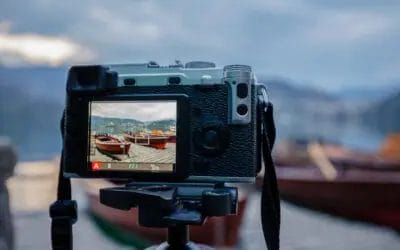
DSLR vs Mirrorless in 2024: Which Camera is Best for You?
Cameras , How to Use Photo Gear , Tutorials
Discover the pros, cons, and features of each type to help you decide which camera is right for you and your photography needs.

Snow Photography Tips: Your Guide to Taking Great Photos in the Snow
Landscape Photography , Tutorials
Capture the beauty of winter with expert tips on photographing snow! From exposure to composition, learn how to take stunning snowy shots.
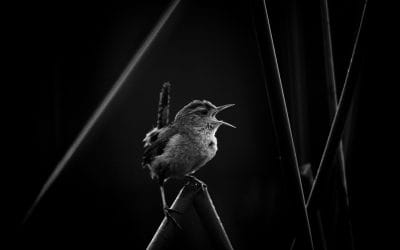
20 Wildlife Photo Contests to Enter (2024)
Tutorials , Wildlife Photography
Check out this list of the best wildlife photo contests and advice on how to enter. Plus get tips on how to maximize your chances of success.
WHAT DO YOU WANT TO READ TODAY?
POPULAR SEARCHES: Best Cameras | Location Guide | Best Lenses | Wildlife
Take The Quiz
Get super clear on exactly what to focus on right now to grow your photography skills fast..
Take the FREE Full Frame Ecosystem Assessment ™ to crack the code on your roadblocks so you can hop into the creativity express lane with personalized action steps!
Ready to level up your awesome?
Start your next learning adventure.

52 Week Creativity Kit
A year of weekly bite-sized nature photography concepts and challenges that strengthen your camera skills and provide endless inspiration.
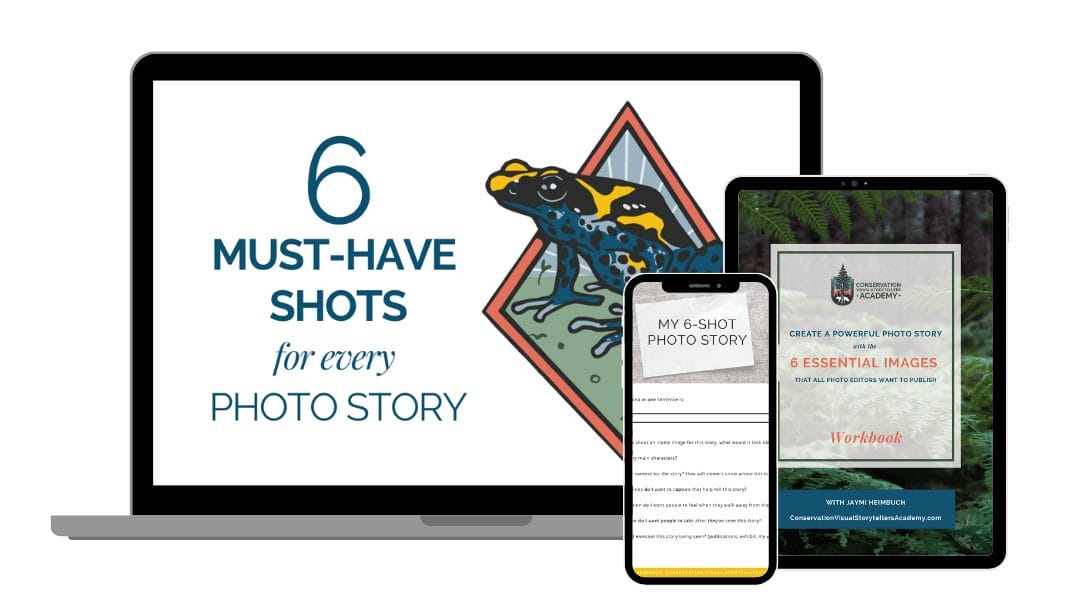
6 Must-Have Shots for a Photo Story
New to photo stories? Start by learning how to create a powerful photo story with the 6 essential images that all photo editors want to publish.
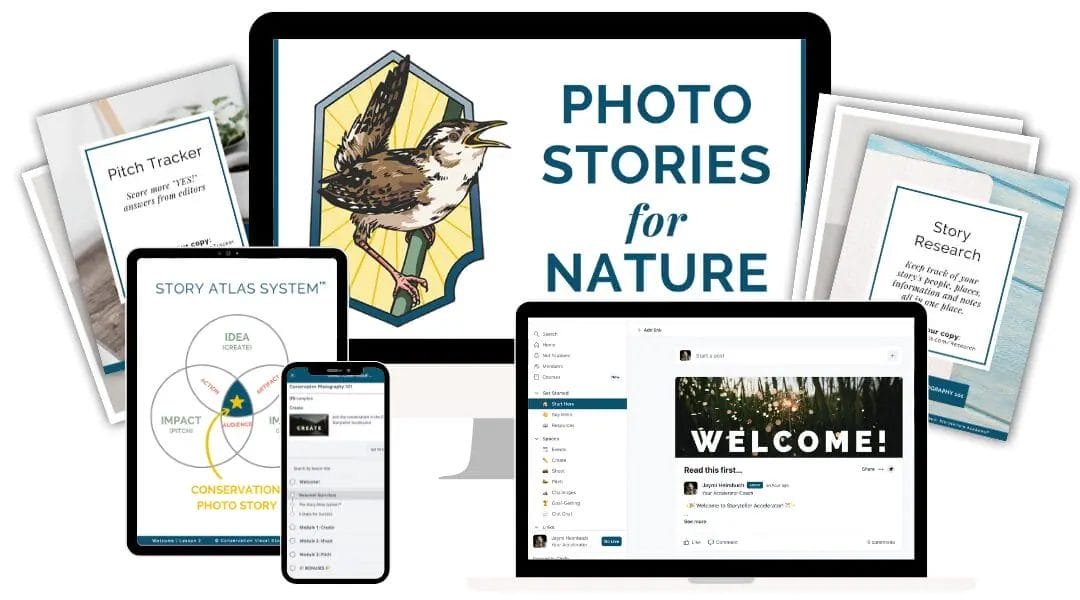
Photo Stories for Nature
Master how to photograph impressive photo stories and effectively share them so they make an impact.

Conservation Filmmaking 101
Master how to craft powerfully moving films that create conservation impact.
Get The Most Popular Free Resources
Make leaps forward in your visual storytelling download three of our most valuable free resources for photographers..

Ready to take better photos?
Get all the good things delivered.
Photography how-to guides, expert interviews, behind-the-scenes insights & more all delivered to your inbox weekly.
Privacy Overview

- Student Successes
- My Learning
17 Awesome Photo Essay Examples You Should Try Yourself
You can also select your interests for free access to our premium training:
If you’re looking for a photo essay example (or 17!), you’ve come to the right place. But what is the purpose of a photo essay? A photo essay is intended to tell a story or evoke emotion from the viewers through a series of photographs. They allow you to be creative and fully explore an idea. But how do you make one yourself? Here’s a list of photo essay examples. Choose one that you can easily do based on your photographic level and equipment.
Top 17 Photo Essay Examples
Here are some fantastic ideas to get you inspired to create your own photo essays!
17. Photograph a Protest

16. Transformation Photo Essays

15. Photograph the Same Place

14. Create a Photowalk

13. Follow the Change

12. Photograph a Local Event

11. Photograph an Abandoned Building

10. Behind the Scenes of a Photo Shoot

9. Capture Street Fashion

8. Landmark Photo Essay

7. Fathers & Children

6. A Day In the Life

5. Education Photo Essay

4. Fictitious Meals

3. Photograph Coffee Shops Using Cafenol

2. Photograph the Photographers

1. Capture the Neighbors

Photo essays tell stories. And there are plenty of amazingly interesting stories to tell! Photographing photo essays is a great way to practice your photography skills while having fun. You might even learn something! These photo essay examples are here to provide you with the inspiration to go out and tell your own stories through photos!
Popular Content

Overview of web animation and graphics programs
Pictorial Writing Examples: Visual Storytelling Mastery
In the realm of storytelling, pictorial writing emerges as a captivating fusion of artistry and narrative ingenuity. This curated collection of pictorial writing examples beckons you to explore the diverse and enriching world of visual narratives.
From the echoes of historical chronicles to the reflections of contemporary issues, each example serves as a testament to the profound impact that arises from the harmonious integration of visuals and storytelling.
What is Pictorial Writing?
Pictorial writing, synonymous with visual storytelling, is an expressive narrative form reliant on a sequence of images to unfold a story, elicit emotions, and communicate information.
Rooted in the early 20th century, luminaries like Lewis Hine pioneered this medium by documenting the stark realities of child labor, propelling pictorial writing into a potent conduit for journalistic and artistic expression.
Key Elements of Pictorial Writing
Pictorial essays, characterized by a series of images crafting a cohesive narrative or conveying specific information, seamlessly blend visuals and text. This format allows for diverse storytelling, encompassing chronological narratives and capturing singular moments united by a common thematic thread.
Crafting Compelling Pictorial Essays
Design Techniques:
- Scrollytelling Images: Foster viewer engagement by smoothly transitioning between photos overlaid with text, offering a dynamic approach to presenting visual narratives;
- Scroll Speed and Progress Bars: Enhance user experience by varying scroll speeds and incorporating progress bars, preventing content fatigue and guiding readers seamlessly through the essay;
- Image Comparison Slider: Showcase transformations through an interactive image comparison slider, allowing viewers to explore before-and-after visuals;
- Clickable Image Hotspots: Maximize screen space with clickable hotspots, providing additional information and enhancing the overall storytelling experience;
- Image Carousels: Facilitate interactive navigation with horizontally navigable image carousels, creating an engaging and immersive storytelling experience.
Best Practices for Design:
- Knowing Your Story: Ensure clarity and coherence by identifying the main points you want to visually convey in your pictorial essay;
- Diverse Shot Selection: Sustain viewer interest by incorporating varied angles, close-ups, and compositions, steering clear of monotony;
- Selecting the Best Images: Prioritize relevance over aesthetics, ensuring each photo contributes meaningfully to the narrative;
- Audience Consideration:Tailor your style and tone to the target demographic, resonating effectively with the intended audience;
- Maintaining Momentum: Employ scroll-triggered transitions, animations, and interactivity to captivate viewers, ensuring sustained engagement throughout the essay.
Pictorial Writing Examples: From Egmont to Taranaki
Immerse yourself in the compelling Vev-built pictorial essay, “From Egmont to Taranaki,” where personal narratives intertwine with historical lessons. Animated effects and scrollytelling techniques elevate the visual journey, creating a captivating exploration.
Food for Thought
Offering a global lens on food production, “Food for Thought” utilizes fixed image parallax scrolling and hotspots to provide a comprehensive view of people, landscapes, and processes. This example exemplifies the potential for depth and engagement within pictorial storytelling.
Witnesses to History Keepers of Memory
The Montreal Holocaust Museum’s interactive creation delves into the lives of Holocaust survivors, utilizing hover-triggered animations and a thoughtful narrative structure to convey a powerful message. This example demonstrates the impactful potential of visual storytelling.
Hakai Autonomous Ocean
Delve into the oceanic realm with “Hakai Autonomous Ocean,” a single-page essay showcasing scrollytelling images and image comparison sliders. Narrating the story of a malfunctioning $150,000 robot beneath the sea, this example immerses the audience in a dramatic and engaging experience.
Moma Strange Brew
Unveiling the creation of John Klines’ art installation, “Skittles,” this essay employs humor and satire to explore consumerism. The step-by-step visual journey is complemented by fade-ins and interactive elements, showcasing the potential for creativity within the pictorial writing format.
Documenting UNICEF’s humanitarian efforts through photographer Jan Grarup, this pictorial essay reveals the organization’s Denmark warehouse and its impact in various countries. The inclusion of a scroll progress bar aids navigation, providing a seamless and informative visual journey.
The Guardian
“Slippery slope? Alpine tourism in the face of climate crisis” delves into the interplay between climate change and the Alps. Image comparison sliders showcase the region in both winter and other seasons, maximizing screen space for impactful visuals and fostering a deeper understanding of global issues.
The Naija Story
Divided into sections covering politics, technology, and entertainment, “The Naija Story” effectively utilizes photo essays to highlight Nigeria’s history. Scroll-triggered animations and connecting lines simplify the narrative for an artistic yet easily comprehensible presentation, making history accessible through visual storytelling.
Ukrainian Ballerina Uprooted by War Flies High Again
A poignant piece from Reuters, this essay chronicles the journey of ballet dancer Ganna Muromtseva, seamlessly blending writing and photos. The use of fade-ins and text overlays adds a dynamic touch to the visual storytelling, providing a personal and emotional insight into the subject’s life.
Creating Stunning Pictorial Essays with Vev
Vev stands as a creative powerhouse, offering a myriad of tools to bring pictorial essays to life. Image comparison sliders, carousels, scroll animations, and other pre-built elements empower storytellers, eliminating the need for complex coding.
Features: Image Comparison Sliders, Carousels, Scroll Animations
Vev’s user-friendly interface allows journalists, designers, and publishers to seamlessly integrate dynamic elements into their visual content. Image comparison sliders showcase transformations, carousels enable interactive navigation, and scroll animations enhance the overall storytelling experience. With Vev, the creative possibilities of visual storytelling are boundless.
Conclusion
The art of pictorial writing serves as a beacon for storytellers navigating the complex digital landscape. The convergence of visual aesthetics and narrative impact, coupled with meticulous design techniques and best practices, unveils the true potential of this unique medium.
Whether documenting historical events, unraveling global issues, or presenting personal narratives, pictorial essays offer a distinctive and engaging avenue for storytelling.
With the innovative capabilities of tools like Vev, storytellers can unleash their creativity, ensuring their narratives not only stand out but resonate deeply in a visually saturated digital realm.
- Pressley Robert
You may also like
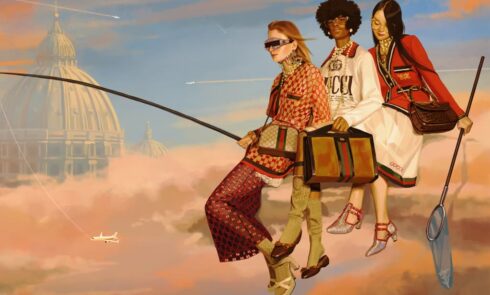
Advertorial Examples: Elevate Your Content Game
In the dynamic realm of digital marketing, traditional approaches often..

Effective Web Carousel Design
Are you looking to revamp your website with a dynamic..
- PRO Courses Guides New Tech Help Pro Expert Videos About wikiHow Pro Upgrade Sign In
- EDIT Edit this Article
- EXPLORE Tech Help Pro About Us Random Article Quizzes Request a New Article Community Dashboard This Or That Game Popular Categories Arts and Entertainment Artwork Books Movies Computers and Electronics Computers Phone Skills Technology Hacks Health Men's Health Mental Health Women's Health Relationships Dating Love Relationship Issues Hobbies and Crafts Crafts Drawing Games Education & Communication Communication Skills Personal Development Studying Personal Care and Style Fashion Hair Care Personal Hygiene Youth Personal Care School Stuff Dating All Categories Arts and Entertainment Finance and Business Home and Garden Relationship Quizzes Cars & Other Vehicles Food and Entertaining Personal Care and Style Sports and Fitness Computers and Electronics Health Pets and Animals Travel Education & Communication Hobbies and Crafts Philosophy and Religion Work World Family Life Holidays and Traditions Relationships Youth
- Browse Articles
- Learn Something New
- Quizzes Hot
- This Or That Game New
- Train Your Brain
- Explore More
- Support wikiHow
- About wikiHow
- Log in / Sign up
- Education and Communications
- College University and Postgraduate
- Academic Writing
How to Make a Photo Essay
Last Updated: September 27, 2023 Fact Checked
This article was co-authored by Heather Gallagher . Heather Gallagher is a Photojournalist & Photographer based in Austin, Texas. She runs her own photography studio named "Heather Gallagher Photography" which was voted Austin's Best Family Photographer and top 3 Birth Photographers in 2017, 2018, and 2019. Heather specializes in family Photojournalism and has over 15 years of experience documenting individuals, families, and businesses all over the world. Her clients include Delta Airlines, Oracle, Texas Monthly, and her work has been featured in The Washington Post and The Austin American Statesman. She is a member of the International Association of Professional Birth Photographers (IAPBP). There are 11 references cited in this article, which can be found at the bottom of the page. This article has been fact-checked, ensuring the accuracy of any cited facts and confirming the authority of its sources. This article has been viewed 287,037 times.
Photo essays are an increasingly popular medium for journalists, bloggers, and advertisers alike. Whether you’re trying to show the emotional impact of a current news story or share your hobby with friends and family, images can capture your topic in a personal, emotional, and interesting way. Creating a photo essay can be as easy as choosing a topic, getting your images, and organizing the essay.
Things You Should Know
- Reflect long and hard on your topic, considering your audience, current events, and whether to go for a thematic or narrative approach.
- Create an outline, including your focus image, establishing shot, clincher, and other image details.
- When you finally take your photos, remember to take more photos than you think you need and don't be afraid to let the project change as you create it.
Finding Your Topic

- Offer a photo essay of your place of business as a training tool.
- Use a photo essay about your business as a sales or social tool by publishing it on your website or social media page.
- Create a how to photo essay to help others learn about your hobby, so they can take it up as well. [4] X Research source

- Thematic subjects are big ideas including things like local gun laws, at-risk youth, or welcoming home soldiers.
- Narrative essays can include a day in the life, how to tutorials, or progression series that show changes over time such as tracking a building project.
- If you have been given a commission or specific publication to work with, you may need to choose a topic that will fit a thematic or narrative approach as outlined by the publication. Make sure you are aware of any publication guidelines in advance.
Organizing Your Shoot

- Consider how difficult it will be to get permission to photograph your subjects. If you already have relationships established, it will be easier. If not, allow for extra time to get permission and/or waivers.
- Schools, daycares, and other places with kids typically have more regulations on who can be photographed and for what purposes. You’ll usually need to get parental approval, in addition to permission from those in charge. [7] X Research source

- Consider doing interviews with people involved prior to the shoot. Ask things like, “What’s the most interesting thing you do during this event?” or “How long have you been involved with this organization?”
- These interviews are also a great opportunity to ask for permission and get waivers.
- If you’re going to visit a job site, charitable event, or other large group activity, ask the person or persons in charge to explain what you’re doing to everyone before you arrive. [8] X Research source

Capturing Your Images

- Many new photographers stay away from high ISO shots because they allow more light through producing a “busy” image. However, these images are often easier to edit later as there’s more information to work with. [11] X Research source
- If it’s very bright in your location or you’ve set up artificial lighting, a low ISO is likely adequate, For darker areas, you’ll likely need to use a higher ISO.
- If you need one second to capture an image with a base ISO of 100, you’ll need one eighth of a second to capture with an ISO of 800. [13] X Research source

- Even snapping candid shots, which you may need to capture quickly, take a few moments to think about how objects are placed to make the most impact.
- Always think about how the main subject’s surroundings play into the overall image, and try to create different levels and points of interest.
- You can change composition as part of the editing process in some cases, so if you can’t line up the shot just right, don’t let it deter you from capturing the image you want. [14] X Research source

Organizing the Essay

- If you’re doing a day in the life photo essay about a frustrated person working in an office, an image of that person struggling to open the front door against the wind might be an apt focus shot.
- If your essay is about the process of building a home, your focus image may be something like a contractor and architect looking at blue prints with the framed up home in the background.
- If your essay is about a family reunion, the focus image may be a funny shot of the whole family making faces, pretending to be fighting, or a serious photo of the family posed together. Capture whatever seems natural for the family. [18] X Research source

- Regardless of essay type, you’ll need a focus image to grab attention.
- Use an overall shot to give context to your essay. Where is it, when is it happening, who’s involved, what’s going on, and why should someone be interested? The five “W’s” of journalism are a great way to determine what your overall shot should capture.
- Find your final image. This should be something provocative that asks your viewer to think about the topic.
- Between the focus and overall shot and ending image, include a series of images that move the viewer from the lead-in shots to its result. Use images that build in intensity or draw the viewers further into the essay.

- If the images aren’t telling the story, ask your friends to look at your other photos and ask, “I wanted this image to make this point. You got a different idea. Would any of these images make this point to you more clearly?”
- If the others like the images you’ve chosen, you may still want to ask them to look at your other photos and tell you if they think any of the images you didn’t include should be added in. They may see something you missed. [20] X Research source

- If you're commissioned to add photos to an essay, you should make sure images reflect the written word, but also add emotion and context the writing could not capture. For example, an essay on poverty may include an image of a child and parent living on the street could capture more emotional context.
- Captions should only include information the viewer could not derive from the photo itself. For instance, you can include a date, the subject’s name, or a statistic relevant to your subject in the caption.
- If you choose not to have any text or just a title and some introductory and/or closing words, make sure you convey all necessary information succinctly. [21] X Research source
Expert Q&A

- Be creative with your topics. However, something as simple as "things I like" will suffice so long as you stay creative. Thanks Helpful 0 Not Helpful 0
- Make sure you're familiar with your camera. It will make the photo composition a lot easier. Thanks Helpful 0 Not Helpful 0
- Don't get discouraged. It may take several tries to get the desired results in your photos. Thanks Helpful 1 Not Helpful 0

You Might Also Like

- ↑ http://digital-photography-school.com/5-photo-essay-tips/
- ↑ Heather Gallagher. Professional Photojournalist & Photographer. Expert Interview. 8 April 2020.
- ↑ http://improvephotography.com/30816/10-ideas-creative-photo-essays/
- ↑ http://www.apogeephoto.com/how-to-create-a-photo-essay/
- ↑ https://petapixel.com/how-to-create-a-photo-essay/
- ↑ http://photo.journalism.cuny.edu/week-5/
- ↑ http://clickitupanotch.com/2010/12/creating-a-photo-essay/
- ↑ https://photographylife.com/what-is-iso-in-photography
- ↑ https://wiredimpact.com/blog/how-to-make-a-photo-essay-nonprofit/
- ↑ http://digital-photography-school.com/5-tips-for-creating-a-photo-essay-with-a-purpose/
- ↑ https://www.format.com/magazine/resources/photography/how-to-make-photo-essay-examples
About This Article

To make a photo essay, start by selecting a subject that is easy to capture and that inspires you, like a friend or a family pet. Then, decide if you want to present your photo essay as thematic, which shows specific examples of a big idea, or narrative, with a beginning, middle, and end. Next, create an outline of your essay to determine which photos you’ll need, like an establishing shot. Finally, take your photos, select which images you want to use in your essay, and organize them according to your theme before adding text to explain the essay. To learn how to capture the best images, keep scrolling! Did this summary help you? Yes No
- Send fan mail to authors
Reader Success Stories
Aug 3, 2016
Did this article help you?

Sep 24, 2023
Christopher Ulloa Abarua
Mar 16, 2018

Featured Articles

Trending Articles

Watch Articles

- Terms of Use
- Privacy Policy
- Do Not Sell or Share My Info
- Not Selling Info
wikiHow Tech Help Pro:
Develop the tech skills you need for work and life
Pictures That Tell Stories: Photo Essay Examples

Like any other type of artist, a photographer’s job is to tell a story through their pictures. While some of the most creative among us can invoke emotion or convey a thought with one single photo, the rest of us will rely on a photo essay.
In the following article, we’ll go into detail about what a photo essay is and how to craft one while providing some detailed photo essay examples.
What is a Photo Essay?
A photo essay is a series of photographs that, when assembled in a particular order, tell a unique and compelling story. While some photographers choose only to use pictures in their presentations, others will incorporate captions, comments, or even full paragraphs of text to provide more exposition for the scene they are unfolding.
A photo essay is a well-established part of photojournalism and have been used for decades to present a variety of information to the reader. Some of the most famous photo essayists include Ansel Adams , W. Eugene Smith, and James Nachtwey. Of course, there are thousands of photo essay examples out there from which you can draw inspiration.
Why Consider Creating a Photo Essay?
As the old saying goes, “a picture is worth 1000 words.” This adage is, for many photographers, reason enough to hold a photo essay in particularly high regard.
For others, a photo essay allow them to take pictures that are already interesting and construct intricate, emotionally-charged tales out of them. For all photographers, it is yet another skill they can master to become better at their craft.
As you might expect, the photo essay have had a long history of being associated with photojournalism. From the Great Depression to Civil Rights Marches and beyond, many compelling stories have been told through a combination of images and text, or photos alone. A photo essay often evokes an intense reaction, whether artistic in nature or designed to prove a socio-political point.
Below, we’ll list some famous photo essay samples to further illustrate the subject.

Become the photographer you were born to be.
Join Cole’s Classroom
Famous Photo Essays
“The Great Depression” by Dorothea Lange – Shot and arranged in the 1930s, this famous photo essay still serves as a stark reminder of The Great Depression and Dust Bowl America . Beautifully photographed, the black and white images offer a bleak insight to one of the country’s most difficult times.
“The Vietnam War” by Philip Jones Griffiths – Many artists consider the Griffiths’ photo essay works to be some of the most important records of the war in Vietnam. His photographs and great photo essays are particularly well-remembered for going against public opinion and showing the suffering of the “other side,” a novel concept when it came to war photography.
Various American Natural Sites by Ansel Adams – Adams bought the beauty of nature home to millions, photographing the American Southwest and places like Yosemite National Park in a way that made the photos seem huge, imposing, and beautiful.
“Everyday” by Noah Kalina – Is a series of photographs arranged into a video. This photo essay features daily photographs of the artist himself, who began taking capturing the images when he was 19 and continued to do so for six years.
“Signed, X” by Kate Ryan – This is a powerful photo essay put together to show the long-term effects of sexual violence and assault. This photo essay is special in that it remains ongoing, with more subjects being added every year.
Common Types of Photo Essays
While a photo essay do not have to conform to any specific format or design, there are two “umbrella terms” under which almost all genres of photo essays tend to fall. A photo essay is thematic and narrative. In the following section, we’ll give some details about the differences between the two types, and then cover some common genres used by many artists.
⬥ Thematic
A thematic photo essay speak on a specific subject. For instance, numerous photo essays were put together in the 1930s to capture the ruin of The Great Depression. Though some of these presentations followed specific people or families, they mostly told the “story” of the entire event. There is much more freedom with a thematic photo essay, and you can utilize numerous locations and subjects. Text is less common with these types of presentations.

⬥ Narrative
A narrative photo essay is much more specific than thematic essays, and they tend to tell a much more direct story. For instance, rather than show a number of scenes from a Great Depression Era town, the photographer might show the daily life of a person living in Dust Bowl America. There are few rules about how broad or narrow the scope needs to be, so photographers have endless creative freedom. These types of works frequently utilize text.
Common Photo Essay Genres
Walk a City – This photo essay is when you schedule a time to walk around a city, neighborhood, or natural site with the sole goal of taking photos. Usually thematic in nature, this type of photo essay allows you to capture a specific place, it’s energy, and its moods and then pass them along to others.
The Relationship Photo Essay – The interaction between families and loved ones if often a fascinating topic for a photo essay. This photo essay genre, in particular, gives photographers an excellent opportunity to capture complex emotions like love and abstract concepts like friendship. When paired with introspective text, the results can be quite stunning.
The Timelapse Transformation Photo Essay – The goal of a transformation photo essay is to capture the way a subject changes over time. Some people take years or even decades putting together a transformation photo essay, with subjects ranging from people to buildings to trees to particular areas of a city.
Going Behind The Scenes Photo Essay – Many people are fascinated by what goes on behind the scenes of big events. Providing the photographer can get access; to an education photo essay can tell a very unique and compelling story to their viewers with this photo essay.
Photo Essay of a Special Event – There are always events and occasions going on that would make an interesting subject for a photo essay. Ideas for this photo essay include concerts, block parties, graduations, marches, and protests. Images from some of the latter were integral to the popularity of great photo essays.
The Daily Life Photo Essay – This type of photo essay often focus on a single subject and attempt to show “a day in the life” of that person or object through the photographs. This type of photo essay can be quite powerful depending on the subject matter and invoke many feelings in the people who view them.
Become the photographer of your dreams with Cole’s Classroom.
Start Free Trial
Photo Essay Ideas and Examples
One of the best ways to gain a better understanding of photo essays is to view some photo essay samples. If you take the time to study these executions in detail, you’ll see just how photo essays can make you a better photographer and offer you a better “voice” with which to speak to your audience.
Some of these photo essay ideas we’ve already touched on briefly, while others will be completely new to you.
Cover a Protest or March
Some of the best photo essay examples come from marches, protests, and other events associated with movements or socio-political statements. Such events allow you to take pictures of angry, happy, or otherwise empowered individuals in high-energy settings. The photo essay narrative can also be further enhanced by arriving early or staying long after the protest has ended to catch contrasting images.
Photograph a Local Event
Whether you know it or not, countless unique and interesting events are happening in and around your town this year. Such events provide photographers new opportunities to put together a compelling photo essay. From ethnic festivals to historical events to food and beverage celebrations, there are many different ways to capture and celebrate local life.
Visit an Abandoned Site or Building
Old homes and historical sites are rich with detail and can sometimes appear dilapidated, overgrown by weeds, or broken down by time. These qualities make them a dynamic and exciting subject. Many great photo essay works of abandoned homes use a mix of far-away shots, close-ups, weird angles, and unique lighting. Such techniques help set a mood that the audience can feel through the photographic essay.
Chronicle a Pregnancy
Few photo essay topics could be more personal than telling the story of a pregnancy. Though this photo essay example can require some preparation and will take a lot of time, the results of a photographic essay like this are usually extremely emotionally-charged and touching. In some cases, photographers will continue the photo essay project as the child grows as well.
Photograph Unique Lifestyles
People all over the world are embracing society’s changes in different ways. People live in vans or in “tiny houses,” living in the woods miles away from everyone else, and others are growing food on self-sustaining farms. Some of the best photo essay works have been born out of these new, inspiring movements.
Photograph Animals or Pets
If you have a favorite animal (or one that you know very little about), you might want to arrange a way to see it up close and tell its story through images. You can take photos like this in a zoo or the animal’s natural habitat, depending on the type of animal you choose. Pets are another great topic for a photo essay and are among the most popular subjects for many photographers.
Show Body Positive Themes
So much of modern photography is about showing the best looking, prettiest, or sexiest people at all times. Choosing a photo essay theme like body positivity, however, allows you to film a wide range of interesting-looking people from all walks of life.
Such a photo essay theme doesn’t just apply to women, as beauty can be found everywhere. As a photo essay photographer, it’s your job to find it!
Bring Social Issues to Life
Some of the most impactful social photo essay examples are those where the photographer focuses on social issues. From discrimination to domestic violence to the injustices of the prison system, there are many ways that a creative photographer can highlight what’s wrong with the world. This type of photo essay can be incredibly powerful when paired with compelling subjects and some basic text.
Photograph Style and Fashion
If you live in or know of a particularly stylish locale or area, you can put together an excellent thematic photo essay by capturing impromptu shots of well-dressed people as they pass by. As with culture, style is easily identifiable and is as unifying as it is divisive. Great photo essay examples include people who’ve covered fashion sub-genres from all over the world, like urban hip hop or Japanese Visual Kei.
Photograph Native Cultures and Traditions
If you’ve ever opened up a copy of National Geographic, you’ve probably seen photo essay photos that fit this category. To many, the traditions, dress, religious ceremonies, and celebrations of native peoples and foreign cultures can be utterly captivating. For travel photographers, this photo essay is considered one of the best ways to tell a story with or without text.
Capture Seasonal Or Time Changes In A Landmark Photo Essay
Time-lapse photography is very compelling to most viewers. What they do in a few hours, however, others are doing over months, years, and even decades. If you know of an exciting landscape or scene, you can try to capture the same image in Winter, Spring, Summer, and Fall, and put that all together into one landmark photo essay.
Alternatively, you can photograph something being lost or ravaged by time or weather. The subject of your landmark photo essay can be as simple as the wall of an old building or as complex as an old house in the woods being taken over by nature. As always, there are countless transformation-based landmark photo essay works from which you can draw inspiration.
Photograph Humanitarian Efforts or Charity
Humanitarian efforts by groups like Habitat for Humanity, the Red Cross, and Doctors Without Borders can invoke a powerful response through even the simplest of photos. While it can be hard to put yourself in a position to get the images, there are countless photo essay examples to serve as inspiration for your photo essay project.
How to Create a Photo Essay
There is no singular way to create a photo essay. As it is, ultimately, and artistic expression of the photographer, there is no right, wrong, good, or bad. However, like all stories, some tell them well and those who do not. Luckily, as with all things, practice does make perfect. Below, we’ve listed some basic steps outlining how to create a photo essay
Steps To Create A Photo Essay
Choose Your Topic – While some photo essayists will be able to “happen upon” a photo story and turn it into something compelling, most will want to choose their photo essay topics ahead of time. While the genres listed above should provide a great starting place, it’s essential to understand that photo essay topics can cover any event or occasion and any span of time
Do Some Research – The next step to creating a photo essay is to do some basic research. Examples could include learning the history of the area you’re shooting or the background of the person you photograph. If you’re photographing a new event, consider learning the story behind it. Doing so will give you ideas on what to look for when you’re shooting.
Make a Storyboard – Storyboards are incredibly useful tools when you’re still in the process of deciding what photo story you want to tell. By laying out your ideas shot by shot, or even doing rough illustrations of what you’re trying to capture, you can prepare your photo story before you head out to take your photos.
This process is especially important if you have little to no control over your chosen subject. People who are participating in a march or protest, for instance, aren’t going to wait for you to get in position before offering up the perfect shot. You need to know what you’re looking for and be prepared to get it.
Get the Right Images – If you have a shot list or storyboard, you’ll be well-prepared to take on your photo essay. Make sure you give yourself enough time (where applicable) and take plenty of photos, so you have a lot from which to choose. It would also be a good idea to explore the area, show up early, and stay late. You never know when an idea might strike you.
Assemble Your Story – Once you develop or organize your photos on your computer, you need to choose the pictures that tell the most compelling photo story or stories. You might also find some great images that don’t fit your photo story These can still find a place in your portfolio, however, or perhaps a completely different photo essay you create later.
Depending on the type of photographer you are, you might choose to crop or digitally edit some of your photos to enhance the emotions they invoke. Doing so is completely at your discretion, but worth considering if you feel you can improve upon the naked image.

Ready to take your photography to the next level?
Join Cole’s Classroom today! »
Best Photo Essays Tips And Tricks
Before you approach the art of photo essaying for the first time, you might want to consider with these photo essay examples some techniques, tips, and tricks that can make your session more fun and your final results more interesting. Below, we’ve compiled a list of some of the best advice we could find on the subject of photo essays.
⬥ Experiment All You Want
You can, and should, plan your topic and your theme with as much attention to detail as possible. That said, some of the best photo essay examples come to us from photographers that got caught up in the moment and decided to experiment in different ways. Ideas for experimentation include the following:
Angles – Citizen Kane is still revered today for the unique, dramatic angles used in the film. Though that was a motion picture and not photography, the same basic principles still apply. Don’t be afraid to photograph some different angles to see how they bring your subject to life in different ways.
Color – Some images have more gravitas in black in white or sepia tone. You can say the same for images that use color in an engaging, dynamic way. You always have room to experiment with color, both before and after the shoot.
Contrast – Dark and light, happy and sad, rich and poor – contrast is an instantly recognizable form of tension that you can easily include in your photo essay. In some cases, you can plan for dramatic contrasts. In other cases, you simply need to keep your eyes open.
Exposure Settings – You can play with light in terms of exposure as well, setting a number of different moods in the resulting photos. Some photographers even do random double exposures to create a photo essay that’s original.
Filters – There are endless post-production options available to photographers, particularly if they use digital cameras. Using different programs and apps, you can completely alter the look and feel of your image, changing it from warm to cool or altering dozens of different settings.
Want to never run out of natural & authentic poses? You need this ⬇️
Click here & get it today for a huge discount., ⬥ take more photos than you need .
If you’re using traditional film instead of a digital camera, you’re going to want to stock up. Getting the right shots for a photo essay usually involves taking hundreds of images that will end up in the rubbish bin. Taking extra pictures you won’t use is just the nature of the photography process. Luckily, there’s nothing better than coming home to realize that you managed to capture that one, perfect photograph.
⬥ Set the Scene
You’re not just telling a story to your audience – you’re writing it as well. If the scene you want to capture doesn’t have the look you want, don’t be afraid to move things around until it does. While this doesn’t often apply to photographing events that you have no control over, you shouldn’t be afraid to take a second to make an OK shot a great shot.
⬥ Capture Now, Edit Later
Editing, cropping, and digital effects can add a lot of drama and artistic flair to your photos. That said, you shouldn’t waste time on a shoot, thinking about how you can edit it later. Instead, make sure you’re capturing everything that you want and not missing out on any unique pictures. If you need to make changes later, you’ll have plenty of time!
⬥ Make It Fun
As photographers, we know that taking pictures is part art, part skill, and part performance. If you want to take the best photo essays, you need to loosen up and have fun. Again, you’ll want to plan for your topic as best as you can, but don’t be afraid to lose yourself in the experience. Once you let yourself relax, both the ideas and the opportunities will manifest.
⬥ It’s All in The Details
When someone puts out a photographic essay for an audience, that work usually gets analyzed with great attention to detail. You need to apply this same level of scrutiny to the shots you choose to include in your photo essay. If something is out of place or (in the case of historical work) out of time, you can bet the audience will notice.
⬥ Consider Adding Text
While it isn’t necessary, a photographic essay can be more powerful by the addition of text. This is especially true of images with an interesting background story that can’t be conveyed through the image alone. If you don’t feel up to the task of writing content, consider partnering with another artist and allowing them tor bring your work to life.
Final Thoughts
The world is waiting to tell us story after story. Through the best photo essays, we can capture the elements of those stories and create a photo essay that can invoke a variety of emotions in our audience.
No matter the type of cameras we choose, the techniques we embrace, or the topics we select, what really matters is that the photos say something about the people, objects, and events that make our world wonderful.
Dream of Being a Pro Photographer?
Join Cole’s Classroom today to make it a reality.
Similar Posts

Your Complete Guide for How to Photograph the Milky Way
If there are clear skies where you are, knowing how to photograph the milky way means you can get some impressive shots from a wide range of locations. Milky way pictures are a staple for many photographers, and you can find an ideal spot despite the level of light pollution in your general area. Planning…

My 3 Step Guide to Capturing Lightning Photos
My 3 Step Guide to Capturing Lightning Photos Lightning, it’s one of the most intense forms of power that Mother Nature can produce other than your tornadoes and hurricanes. It flashes the earth almost 1.4 billion times per year all over the world, and it is just waiting to be photographed! In this article I…

How to Photograph Christmas Morning With You in the Frame!
Because my heart for photography started with my desire to document everyday memories, it’s no surprise that I LOVE taking Christmas morning photos! But since we have had kids, I have found myself more and more aware of the fact that, most of the time, I am not in the frame with my family. For…
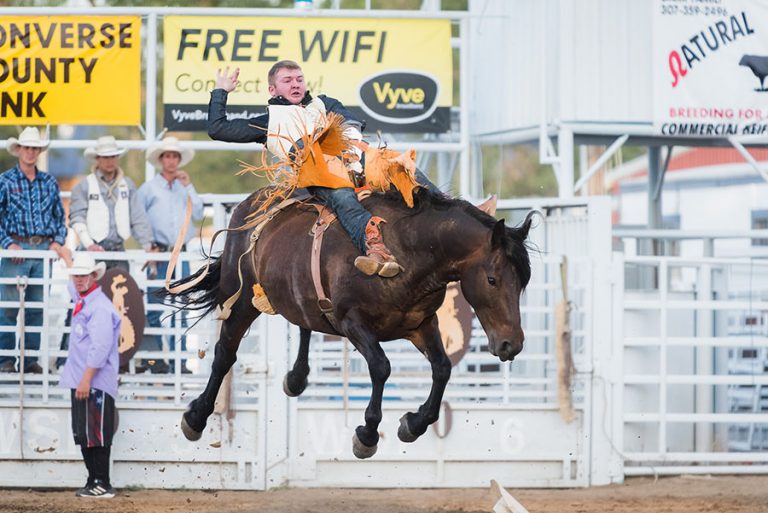
Rodeo Photography: The Ultimate Beginner’s Guide
Saddle up for Action with this Beginner’s Guide to Rodeo Photography Ever heard the expression “This ain’t my first rodeo”? Well, it’s not. I grew up in the shadow of the world’s biggest outdoor rodeo…Cheyenne Frontier Days. I spent many cold mornings at the knee of my father as he announced slack or tagged along…

Using Your Integrated Light Meter, Part Two: Metering Modes
In the first portion of this blog series I discussed how to obtain correct exposure in your camera by following the guidelines of your integrated light meter on your DSLR. Today we will take the process one step further by metering isolated areas of your photo, and discussing the various metering modes. The previous metering…

What is an ND Filter Chart and Should Photographers Use One?
Some photos are beautiful enough to look like blended paintings and can rack in plenty of comments when you post them on your Instagram. However, finding ways to blur or blend the background without using special effects in photoshop can be tricky. One way that photographers can create unique effects without having to do any…
23 Photo Essay Ideas and Examples (to Get Your Creative Juices Flowing!)
A Post By: Kevin Landwer-Johan

Looking for inspiration? Our 23 photo essay ideas will take your photography skills to new heights!
A single, strong photograph can convey a lot of information about its subject – but sometimes we have topics that require more than one image to do the job. That’s when it’s time to make a photo essay: a collection of pictures that together tell the bigger story around a chosen theme.
In the following sections, we’ll explore various photo essay ideas and examples that cover a wide range of subjects and purposes. From capturing the growth of your children to documenting local festivals, each idea offers an exciting opportunity to tell a story through your lens, whether you’re a hobbyist or a veteran professional.
So grab your camera, unleash your creativity, and let’s delve into the wonderful world of photo essay examples!
What is a photo essay?
Simply put, a photo essay is a series of carefully selected images woven together to tell a story or convey a message. Think of it as a visual narrative that designed to capture attention and spark emotions.

Now, these images can revolve around a broad theme or focus on a specific storyline. For instance, you might create a photo essay celebrating the joy of companionship by capturing 10 heartwarming pictures of people sharing genuine laughter. On the other hand, you could have a photo essay delving into the everyday lives of fishermen in Wales by following a single fisherman’s journey for a day or even a week.
It’s important to note that photo essays don’t necessarily have to stick to absolute truth. While some documentary photographers prefer to keep it authentic, others may employ techniques like manipulation or staging to create a more artistic impact. So there is room for creativity and interpretation.
Why you should create a photo essay
Photo essays have a way of expressing ideas and stories that words sometimes struggle to capture. They offer a visual narrative that can be incredibly powerful and impactful.
Firstly, photo essays are perfect when you have an idea or a point you want to convey, but you find yourself at a loss for words. Sometimes, emotions and concepts are better conveyed through images rather than paragraphs. So if you’re struggling to articulate a message, you can let your photos do the talking for you.
Second, if you’re interested in subjects that are highly visual, like the mesmerizing forms of architecture within a single city, photo essays are the way to go. Trying to describe the intricate details of a building or the play of light and shadows with words alone can be challenging. But through a series of captivating images, you can immerse your audience in the architecture.
And finally, if you’re aiming to evoke emotions or make a powerful statement, photo essays are outstanding. Images have an incredible ability to shock, inspire, and move people in ways that words often struggle to achieve. So if you want to raise awareness about an environmental issue or ignite a sense of empathy, a compelling series of photographs can have a profound impact.
Photo essay examples and ideas
Looking to create a photo essay but don’t know where to start? Here are some handy essay ideas and examples for inspiration!
1. A day in the life
Your first photo essay idea is simple: Track a life over the course of one day. You might make an essay about someone else’s life. Or the life of a location, such as the sidewalk outside your house.
The subject matter you choose is up to you. But start in the morning and create a series of images showing your subject over the course of a typical day.
(Alternatively, you can document your subject on a special day, like a birthday, a wedding, or some other celebration.)

2. Capture hands
Portraits focus on a subject’s face – but why not mix it up and make a photo essay that focuses on your subject’s hands?
(You can also focus on a collection of different people’s hands.)
Hands can tell you a lot about a person. And showing them in context is a great way to narrate a story.

3. Follow a sports team for a full season
Sports are all about emotions – both from the passionate players and the dedicated fans. While capturing the intensity of a single game can be exhilarating, imagine the power of telling the complete story of a team throughout an entire season.
For the best results, you’ll need to invest substantial time in sports photography. Choose a team that resonates with you and ensure their games are within a drivable distance. By photographing their highs and lows, celebrations and challenges, you’ll create a compelling photo essay that traces their journey from the first game to the last.
4. A child and their parent
Photographs that catch the interaction between parents and children are special. A parent-child connection is strong and unique, so making powerful images isn’t challenging. You just need to be ready to capture the special moments as they happen.
You might concentrate on a parent teaching their child. Or the pair playing sports. Or working on a special project.
Use your imagination, and you’ll have a great time with this theme.
5. Tell a local artist’s story
I’ve always enjoyed photographing artists as they work; studios have a creative vibe, so the energy is already there. Bring your camera into this environment and try to tell the artist’s story!
An artist’s studio offers plenty of opportunities for wonderful photo essays. Think about the most fascinating aspects of the artist’s process. What do they do that makes their art special? Aim to show this in your photos.
Many people appreciate fine art, but they’re often not aware of what happens behind the scenes. So documenting an artist can produce fascinating visual stories.

6. Show a tradesperson’s process
Do you have a plumber coming over to fix your kitchen sink? Is a builder making you a new deck?
Take photos while they work! Tell them what you want to do before you start, and don’t forget to share your photos with them.
They’ll probably appreciate seeing what they do from another perspective. They may even want to use your photos on their company website.

7. Photograph your kids as they grow
There’s something incredibly special about documenting the growth of our little ones. Kids grow up so quickly – before you know it, they’re moving out. Why not capture the beautiful moments along the way by creating a heartwarming photo essay that showcases their growth?
There are various approaches you can take, but one idea is to capture regular photos of your kids standing in front of a distinct point of reference, such as the refrigerator. Over a year or several years, you can gather these images and place them side by side to witness your childrens’ incredible transformations.
8. Cover a local community event
A school fundraiser, a tree-planting day at a park, or a parade; these are are all community events that make for good photo essay ideas.
Think like a photojournalist . What type of images would your editor want? Make sure to capture some wide-angle compositions , some medium shots, and some close-ups.
(Getting in close to show the details can often tell as much of a story as the wider pictures.)
9. Show fresh market life
Markets are great for photography because there’s always plenty of activity and lots of characters. Think of how you can best illustrate the flow of life at the market. What are the vendors doing that’s most interesting? What are the habits of the shoppers?
Look to capture the essence of the place. Try to portray the people who work and shop there.

10. Shoot the same location over time
What location do you visit regularly? Is there a way you can make an interesting photo essay about it?
Consider what you find most attractive and ugly about the place. Look for aspects that change over time.
Any outdoor location will look different throughout the day. Also think about the changes that occur from season to season. Create an essay that tells the story of the place.
11. Document a local festival
Festivals infuse cities and towns with vibrant energy and unique cultural experiences. Even if your own town doesn’t have notable festivals, chances are a neighboring town does. Explore the magic of these celebrations by documenting a local festival through your lens.
Immerse yourself in the festivities, arriving early and staying late. Capture the colorful displays and the people who make the festival come alive. If the festival spans multiple days, consider focusing on different areas each time you visit to create a diverse and comprehensive photo essay that truly reflects the essence of the event.
12. Photograph a garden through the seasons
It might be your own garden . It could be the neighbor’s. It could even be the garden at your local park.
Think about how the plants change during the course of a year. Capture photos of the most significant visual differences, then present them as a photo essay.

13. Show your local town or city
After spending several years in a particular area, you likely possess an intimate knowledge of your local town or city. Why not utilize that familiarity to create a captivating photo essay that showcases the essence of your community?
Delve into what makes your town special, whether it’s the charming streets, unique landmarks, or the people who shape its character. Dedicate time to capturing the diverse aspects that define your locale. If you’re up for a more extensive project, consider photographing the town over the course of an entire year, capturing the changing seasons and the dynamic spirit of your community.
14. Pick a local cause to highlight
Photo essays can go beyond passive documentation; they can become a part of your activism, too!
So find a cause that matters to you. Tell the story of some aspect of community life that needs improvement. Is there an ongoing issue with litter in your area? How about traffic; is there a problematic intersection?
Document these issues, then make sure to show the photos to people responsible for taking action.
15. Making a meal
Photo essay ideas can be about simple, everyday things – like making a meal or a coffee.
How can you creatively illustrate something that seems so mundane? My guess is that, when you put your mind to it, you can come up with many unique perspectives, all of which will make great stories.

16. Capture the life of a flower
In our fast-paced lives, it’s easy to overlook the beauty that surrounds us. Flowers, with their mesmerizing colors and rapid life cycles, offer a captivating subject for a photo essay. Try to slow down and appreciate the intricate details of a flower’s existence.
With a macro lens in hand, document a single flower or a patch of flowers from their initial shoots to their inevitable wilting and decomposition. Experiment with different angles and perspectives to bring viewers into the enchanting world of the flower. By freezing these fleeting moments, you’ll create a visual narrative that celebrates the cycle of life and the exquisite beauty found in nature’s delicate creations.
17. Religious traditions
Religion is often rich with visual expression in one form or another. So capture it!
Of course, you may need to narrow down your ideas and choose a specific aspect of worship to photograph. Aim to show what people do when they visit a holy place, or how they pray on their own. Illustrate what makes their faith real and what’s special about it.

18. Historic sites
Historic sites are often iconic, and plenty of photographers take a snapshot or two.
But with a photo essay, you can illustrate the site’s history in greater depth.
Look for details of the location that many visitors miss. And use these to build an interesting story.
19. Show the construction of a building
Ever been away from a familiar place for a while only to return and find that things have changed? It happens all the time, especially in areas undergoing constant development. So why not grab your camera and document this transformation?
Here’s the idea: Find a building that’s currently under construction in your area. It could be a towering skyscraper, a modern office complex, or even a small-scale residential project. Whatever catches your eye! Then let the magic of photography unfold.
Make it a habit to take a photo every day or two. Watch as the building gradually takes shape and evolves. Capture the construction workers in action, the cranes reaching for the sky, and the scaffolding supporting the structure.
Once the building is complete, you’ll have a treasure trove of images that chronicle its construction from start to finish!
20. Document the changing skyline of the city
This photo essay example is like the previous one, except it works on a much larger scale. Instead of photographing a single building as it’s built, find a nice vantage point outside your nearest city, then photograph the changing skyline.
To create a remarkable photo essay showcasing the changing skyline, you’ll need to scout out the perfect vantage point. Seek high ground that offers a commanding view of the city, allowing you to frame the skyline against the horizon. Look for spots that give you an unobstructed perspective, whether a rooftop terrace, a hillside park, or even a nearby bridge.
As you set out on your photography expedition, be patient and observant. Cities don’t transform overnight; they change gradually over time. Embrace the passage of days, weeks, and months as you witness the slow evolution unfold.
Pro tip: To capture the essence of this transformation, experiment with various photographic techniques. Play with different angles, framing, and compositions to convey the grandeur and dynamism of the changing skyline. Plus, try shooting during the golden hours of sunrise and sunset , when the soft light bathes the city in a warm glow and accentuates the architectural details.
21. Photograph your pet
If you’re a pet owner, you already have the perfect subject for a photo essay!
All pets , with the possible exception of pet rocks, will provide you with a collection of interesting moments to photograph.
So collect these moments with your camera – then display them as a photo essay showing the nature and character of your pet.

22. Tell the story of a local nature preserve
Ah, the wonders of a local nature preserve! While it may not boast the grandeur of Yosemite National Park, these hidden gems hold their own beauty, just waiting to be discovered and captured through the lens of your camera.
To embark on this type of photo essay adventure, start by exploring all the nooks and crannies of your chosen nature preserve. Wander along its winding trails, keeping an eye out for unique and captivating subjects that convey the essence of the preserve.
As you go along, try to photograph the intricate details of delicate wildflowers, the interplay of light filtering through a dense forest canopy, and the lively activities of birds and other wildlife.
23. Show the same subject from multiple perspectives
It’s possible to create an entire photo essay in a single afternoon – or even in a handful of minutes. If you don’t love the idea of dedicating yourself to days of photographing for a single essay, this is a great option.
Simply find a subject you like, then endeavor to capture 10 unique images that include it. I’d recommend photographing from different angles: up above, down low, from the right and left. You can also try getting experimental with creative techniques, such as intentional camera movement and freelensing. If all goes well, you’ll have a very cool set of images featuring one of your favorite subjects!
By showcasing the same subject from multiple perspectives, you invite viewers on a visual journey. They get to see different facets, textures, and details that they might have overlooked in a single photograph. It adds depth and richness to your photo essay, making it both immersive and dynamic.
Photo essay ideas: final words
Remember: Photo essays are all about communicating a concept or a story through images rather than words. So embrace the process and use images to express yourself!
Whether you choose to follow a sports team through a thrilling season, document the growth of your little ones, or explore the hidden treasures of your local town, each photo essay has its own magic waiting to be unlocked. It’s a chance to explore your creativity and create images in your own style.
So look at the world around you. Grab your gear and venture out into the wild. Embrace the beauty of nature, the energy of a bustling city, or the quiet moments that make life special. Consider what you see every day. What aspects interest you the most? Photograph those things.
You’re bound to end up with some amazing photo essays!
Now over to you:
Do you have any photo essay examples you’re proud of? Do you have any more photo essay ideas? Share your thoughts and images in the comments below!

Read more from our Tips & Tutorials category
Kevin Landwer-Johan is a photographer, photography teacher, and author with over 30 years of experience that he loves to share with others.
Check out his website and his Buy Me a Coffee page .

- Guaranteed for 2 full months
- Pay by PayPal or Credit Card
- Instant Digital Download

- All our best articles for the week
- Fun photographic challenges
- Special offers and discounts


Photo Essay

We all know that photographs tell a story. These still images may be seen from various perspectives and are interpreted in different ways. Oftentimes, photographers like to give dramatic meaning to various scenarios. For instance, a blooming flower signifies a new life. Photographs always hold a deeper meaning than what they actually are.
In essay writing , photographs along with its supporting texts, play a significant role in conveying a message. Here are some examples of these kinds of photo-text combinations.
What is Photo Essay? A photo essay is a visual storytelling method that utilizes a sequence of carefully curated photographs to convey a narrative, explore a theme, or evoke specific emotions. It goes beyond individual images, aiming to tell a cohesive and impactful story through the arrangement and combination of pictures.
Photo Essay Format
A photo essay is a series of photographs that are intended to tell a story or evoke a series of emotions in the viewer. It is a powerful way to convey messages without the need for many words. Here is a format to guide you in creating an effective photo essay:
1. Choose a Compelling Topic
Select a subject that you are passionate about or that you find intriguing. Ensure the topic has a clear narrative that can be expressed visually.
2. Plan Your Shots
Outline the story you wish to tell. This could involve a beginning, middle, and end or a thematic approach. Decide on the types of shots you need (e.g., wide shots, close-ups, portraits, action shots) to best tell the story.
3. Take Your Photographs
Capture a variety of images to have a wide selection when editing your essay. Focus on images that convey emotion, tell a story, or highlight your theme.
4. Edit Your Photos
Select the strongest images that best convey your message or story. Edit for consistency in style, color, and lighting to ensure the essay flows smoothly.
5. Arrange Your Photos
Order your images in a way that makes sense narratively or thematically. Consider transitions between photos to ensure they lead the viewer naturally through the story.
6. Include Captions or Text (Optional)
Write captions to provide context, add depth, or explain the significance of each photo. Keep text concise and impactful, letting the images remain the focus.
7. Present Your Photo Essay
Choose a platform for presentation, whether online, in a gallery, or as a printed booklet. Consider the layout and design, ensuring that it complements and enhances the visual narrative.
8. Conclude with Impact
End with a strong image or a conclusion that encapsulates the essence of your essay. Leave the viewer with something to ponder , reflecting on the message or emotions you aimed to convey.
Best Photo Essay Example?
One notable example of a powerful photo essay is “The Photographic Essay: Paul Fusco’s ‘RFK Funeral Train'” by Paul Fusco. This photo essay captures the emotional journey of the train carrying the body of Robert F. Kennedy from New York to Washington, D.C., after his assassination in 1968. Fusco’s images beautifully and poignantly document the mourning and respect shown by people along the train route. The series is a moving portrayal of grief, unity, and the impact of a historical moment on the lives of ordinary individuals. The photographs are both artistically compelling and deeply human, making it a notable example of the potential for photo essays to convey complex emotions and historical narratives.
Photo Essay Examples and Ideas to Edit & Download
- A Day in the Life Photo Essay
- Behind the scenes Photo Essay
- Event Photo Essay
- Photo Essay on Meal
- Photo Essay on Photo walking
- Photo Essay on Protest
- Photo Essay on Abandoned building
- Education photo essay
- Photo Essay on Events
- Follow the change Photo Essay
- Photo Essay on Personal experiences
Photo Essay Examples & Templates
1. narrative photo essay format example.

nytimes.com
2. Student Photo Essay Example

3. Great Depression Essay Example

thshistory.files.wordpress.com
4. Example of Photo Essay

weresearchit.co.uk
5. Photo Essay Examples About Nature

cge-media-library.s3.ca-central-1.amazonaws.com
6. Travel Photo Example

theguardian.com
7. Free Photo Essay Example

vasantvalley.org
Most Interesting Photo Essays of 2019
Now that you are educated with the fundamentals of photo essays, why not lay eyes on some great photo essays for inspiration. To give you a glimpse of a few epitomes, we collected the best and fascinating photo essays for you. The handpicked samples are as follows:
8. Toys and Us

journals.openedition.org
This photo essay presents its subject which is the latest genre of photography, toy photography. In this type of picture taking, the photographer aims to give life on the toys and treat them as his/her model. This photography follows the idea of a toy researcher, Katrina Heljakka, who states that also adults and not only children are interested in reimagining and preserving the characters of their toys with the means of roleplay and creating a story about these toys. This photo essay is based on the self-reflection of the author on a friend’s toys in their home environment.
9. The Faces of Nature Example

godandnature.asa3.org
This photo essay and collection caters the creativity of the author’s mind in seeing the world. In her composition, she justified that there are millions of faces that are naturally made that some of us have not noticed. She also presented tons of photos showing different natural objects that form patterns of faces. Though it was not mentioned in the essay itself, the author has unconsciously showcased the psychological phenomenon, pareidolia. This is the tendency to translate an obscure stimulus that let the observer see faces in inanimate objects or abstract patterns, or even hearing concealed messages in music.
10. The Country Doctor Example

us1.campaign-archive.com
This photo essay depicts the medical hardships in a small rural town in Colorado called Kremling. For 23 days, Smith shadowed Dr. Ernest Ceriani, witnessing the dramatic life of the small town and capturing the woeful crisis of the region. The picture in this photographic essay was photographed by Smith himself for Life magazine in 1948 but remained as fascinating as it was posted weeks ago.
11. New York City Coffeehouses

lens.blogs.nytimes.com
Café Latte, cappuccino, espresso, or flat white—of course, you know these if you have visited a coffee shop at least once. However, the photographer of this photo essay took it to a whole new level of experience. Within two to three days of visiting various coffee places, Mr. Gavrysh stayed most of his day observing at the finest details such as the source of the coffee, the procedure of delivering them, and the process of roasting and grounding them. He also watched how did the baristas perfect the drinks and the reaction of the customers as they received their ordered coffee with delights in their faces. Gavrysh did not mean to compose a coffeehouse guide, but to make a composition that describes modern, local places where coffee is sipped and treated with respect.
12. Hungry Planet: What The World Eats

13. Photo Essay Example

cah.utexas.edu
14. Photo Essay in PDF

condor.depaul.edu
15. Sample Photo Essay Example

colorado.edu
16. Basic Photo Essay Example

adaptation-undp.org
17. Printable Photo Essay Example

One of the basic necessity of a person to live according to his/her will is food. In this photo essay, you will see how these necessities vary in several ways. In 2005, a pair of Peter Menzel and Faith D’ Aluisio released a book that showcased the meals of an average family in 24 countries. Ecuador, south-central Mali, China, Mexico, Kuwait, Norway, and Greenland are among the nations they visited. This photo essay is written to raise awareness about the influence of environment and culture to the cost and calories of the foods laid on the various dining tables across the globe.
Photo essays are not just about photographic aesthetics but also the stories that authors built behind those pictures. In this collection of captivating photo essays, reflect on how to write your own. If you are allured and still can’t get enough, there’s no need for you to be frantic about. Besides, there are thousands of samples and templates on our website to browse. Visit us to check them all out.
What are good topics for a photo essay?
- Urban Exploration: Document the unique architecture, street life, and cultural diversity of urban environments.
- Environmental Conservation: Capture the beauty of natural landscapes or document environmental issues, showcasing the impact of climate change or conservation efforts.
- Everyday Life in Your Community: Showcase the daily lives, traditions, and activities of people in your local community.
- Family Traditions: Document the customs, rituals, and special moments within your own family or another family.
- Youth Culture: Explore the lifestyle, challenges, and aspirations of young people in your community or around the world.
- Behind-the-Scenes at an Event: Provide a backstage look at the preparation and execution of an event, such as a concert, festival, or sports competition.
- A Day in the Life of a Profession: Follow a professional in their daily activities, offering insights into their work, challenges, and routines.
- Social Issues: Address important social issues like homelessness, poverty, immigration, or healthcare, raising awareness through visual storytelling.
- Cultural Celebrations: Document cultural festivals, ceremonies, or celebrations that showcase the diversity of traditions in your region or beyond.
- Education Around the World: Explore the various facets of education globally, from classrooms to the challenges students face in different cultures.
- Workplace Dynamics: Capture the atmosphere, interactions, and diversity within different workplaces or industries.
- Street Art and Graffiti: Document the vibrant and dynamic world of street art, capturing the expressions of local artists.
- Animal Rescues or Shelters: Focus on the efforts of organizations or individuals dedicated to rescuing and caring for animals.
- Migration Stories: Explore the experiences and challenges of individuals or communities affected by migration.
- Global Food Culture: Document the diversity of food cultures, from local markets to family meals, showcasing the role of food in different societies.
How to Write a Photo Essay
First of all, you would need to find a topic that you are interested in. With this, you can conduct thorough research on the topic that goes beyond what is common. This would mean that it would be necessary to look for facts that not a lot of people know about. Not only will this make your essay interesting, but this may also help you capture the necessary elements for your images.
Remember, the ability to manipulate the emotions of your audience will allow you to build a strong connection with them. Knowing this, you need to plan out your shots. With the different emotions and concepts in mind, your images should tell a story along with the essay outline .
1. Choose Your Topic
- Select a compelling subject that interests you and can be explored visually.
- Consider the story or message you want to convey. It should be something that can be expressed through images.
2. Plan Your Essay
- Outline your narrative. Decide if your photo essay will tell a story with a beginning, middle, and end, or if it will explore a theme or concept.
- Research your subject if necessary, especially if you’re covering a complex or unfamiliar topic.
3. Capture Your Images
- Take a variety of photos. Include wide shots to establish the setting, close-ups to show details, and medium shots to focus on subjects.
- Consider different angles and perspectives to add depth and interest to your essay.
- Shoot more than you need. Having a large selection of images to choose from will make the editing process easier.
4. Select Your Images
- Choose photos that best tell your story or convey your theme.
- Look for images that evoke emotion or provoke thought.
- Ensure there’s a mix of compositions to keep the viewer engaged.
- Sequence your images in a way that makes narrative or thematic sense.
- Consider the flow and how each image transitions to the next.
- Use juxtaposition to highlight contrasts or similarities.
6. Add Captions or Text (Optional)
- Write captions to provide context or additional information about each photo. Keep them brief and impactful.
- Consider including an introduction or conclusion to frame your essay. This can be helpful in setting the stage or offering a final reflection.
7. Edit and Refine
- Review the sequence of your photos. Make sure they flow smoothly and clearly convey your intended story or theme.
- Adjust the layout as needed, ensuring that the visual arrangement is aesthetically pleasing and supports the narrative.
8. Share Your Essay
- Choose the right platform for your photo essay, whether it’s a blog, online publication, exhibition, or print.
- Consider your audience and tailor the presentation of your essay to suit their preferences and expectations.
Types of Photo Essay
Photo essays are a compelling medium to tell a story, convey emotions, or present a perspective through a series of photographs. Understanding the different types of photo essays can help photographers and storytellers choose the best approach for their project. Here are the main types of photo essays:
1. Narrative Photo Essays
- Purpose: To tell a story or narrate an event in a chronological sequence.
- Characteristics: Follows a clear storyline with a beginning, middle, and end. It often includes characters, a setting, and a plot.
- Examples: A day in the life of a firefighter, the process of crafting traditional pottery.
2. Thematic Photo Essays
- Purpose: To explore a specific theme, concept, or issue without being bound to a chronological sequence.
- Characteristics: Centers around a unified theme, with each photo contributing to the overall concept.
- Examples: The impact of urbanization on the environment, the beauty of natural landscapes.
3. Conceptual Photo Essays
- Purpose: To convey an idea or evoke a series of emotions through abstract or metaphorical images.
- Characteristics: Focuses on delivering a conceptual message or emotional response, often using symbolism.
- Examples: Loneliness in the digital age, the concept of freedom.
4. Expository or Informative Photo Essays
- Purpose: To inform or educate the viewer about a subject with a neutral viewpoint.
- Characteristics: Presents factual information on a topic, often accompanied by captions or brief texts to provide context.
- Examples: The process of coffee production, a day at an animal rescue center.
5. Persuasive Photo Essays
- Purpose: To convince the viewer of a particular viewpoint or to highlight social issues.
- Characteristics: Designed to persuade or elicit action, these essays may focus on social, environmental, or political issues.
- Examples: The effects of plastic pollution, the importance of historical preservation.
6. Personal Photo Essays
- Purpose: To express the photographer’s personal experiences, emotions, or journeys.
- Characteristics: Highly subjective and personal, often reflecting the photographer’s intimate feelings or experiences.
- Examples: A personal journey through grief, documenting one’s own home during quarantine.
7. Environmental Photo Essays
- Purpose: To showcase landscapes, wildlife, and environmental issues.
- Characteristics: Focuses on the natural world or environmental challenges, aiming to raise awareness or appreciation.
- Examples: The melting ice caps, wildlife in urban settings.
8. Travel Photo Essays
- Purpose: To explore and present the culture, landscapes, people, and experiences of different places.
- Characteristics: Captures the essence of a location, showcasing its uniqueness and the experiences of traveling.
- Examples: A road trip across the American Southwest, the vibrant streets of a bustling city.
How do you start a picture essay?
1. choose a compelling theme or topic:.
Select a theme or topic that resonates with you and has visual storytelling potential. It could be a personal project, an exploration of a social issue, or a visual journey through a specific place or event.
2. Research and Conceptualize:
Conduct research on your chosen theme to understand its nuances, context, and potential visual elements. Develop a conceptual framework for your photo essay, outlining the key aspects you want to capture.
3. Define Your Storytelling Approach:
Determine how you want to convey your narrative. Consider whether your photo essay will follow a chronological sequence, a thematic structure, or a more abstract and conceptual approach.
4. Create a Shot List:
Develop a list of specific shots you want to include in your essay. This can help guide your photography and ensure you capture a diverse range of images that contribute to your overall narrative.
5. Plan the Introduction:
Think about how you want to introduce your photo essay. The first image or series of images should grab the viewer’s attention and set the tone for the narrative.
6. Consider the Flow:
Plan the flow of your photo essay, ensuring a logical progression of images that tells a cohesive and engaging story. Consider the emotional impact and visual variety as you sequence your photographs.
7. Shoot with Purpose:
Start capturing images with your conceptual framework in mind. Focus on images that align with your theme and contribute to the overall narrative. Look for moments that convey emotion, tell a story, or reveal aspects of your chosen subject.
8. Experiment with Perspectives and Techniques:
Explore different perspectives, compositions, and photographic techniques to add visual interest and depth to your essay. Consider using a variety of shots, including wide-angle, close-ups, and detail shots.
9. Write Descriptive Captions:
As you capture images, think about the accompanying captions. Captions should provide context, additional information, or insights that enhance the viewer’s understanding of each photograph.
What are the key elements of a photo essay?
1. Theme or Topic:
Clearly defined subject matter or theme that unifies the photographs and tells a cohesive story.
2. Narrative Structure:
An intentional narrative structure that guides the viewer through the photo essay, whether chronological, thematic, or conceptual.
3. Introduction:
A strong introduction that captures the viewer’s attention and sets the tone for the photo essay.
4. Captivating Images:
A series of high-quality and visually compelling images that effectively convey the chosen theme or story.
5. Variety of Shots:
A variety of shots, including wide-angle, close-ups, detail shots, and different perspectives, to add visual interest and depth.
6. Sequencing:
Careful sequencing of images to create a logical flow and emotional impact, guiding the viewer through the narrative.
7. Captions and Text:
Thoughtful captions or accompanying text that provide context, additional information, or insights, enhancing the viewer’s understanding.
8. Conclusion:
A concluding section that brings the photo essay to a satisfying close, leaving a lasting impression on the viewer.
Purpose of a Photo Essay
With good writing skills , a person is able to tell a story through words. However, adding images for your essay will give it the dramatic effect it needs. The photographs and the text work hand in hand to create something compelling enough to attract an audience.
This connection goes beyond something visual, as photo essays are also able to connect with an audience emotionally. This is to create an essay that is effective enough to relay a given message.
5 Tips for Creating a Photo Essay
- Don’t be afraid to experiment. Find the right angle and be dramatic with your description, just be creative.
- Pay attention to detail. Chances are, your audience will notice every single detail of your photograph.
- Shoot everything. Behind a single beautiful photo is a hundred more shots.
- Don’t think twice about editing. Editing is where the magic happens. It has the ability to add more drama to your images.
- Have fun. Don’t stress yourself out too much but instead, grow from your experience.
What is a photo essay for school?
A school photo essay is a visual storytelling project for educational purposes, typically assigned to students. It involves creating a narrative using a series of carefully curated photographs on a chosen theme.
How many pictures should be in a photo essay?
The number of pictures in a photo essay varies based on the chosen theme and narrative structure. It can range from a few impactful images to a more extensive series, typically around 10-20 photographs.
Is a photo essay a story?
Yes, a photo essay is a visual storytelling form. It uses a series of carefully curated photographs to convey a narrative, evoke emotions, or communicate a specific message or theme.
What makes a photo essay unforgettable?
An unforgettable photo essay is characterized by a powerful theme, emotionally resonant images, a well-crafted narrative structure, attention to detail, and a connection that leaves a lasting impact on viewers.

Photo Essay Generator
Text prompt
- Instructive
- Professional
Create a Photo Essay on the theme of urban exploration.
Discuss the story of a local community event through a Photo Essay.
- Grades 6-12
- School Leaders
FREE Book Bracket Template. For March and Beyond!
Teaching the Photo Essay
A picture is worth 1,000 words.
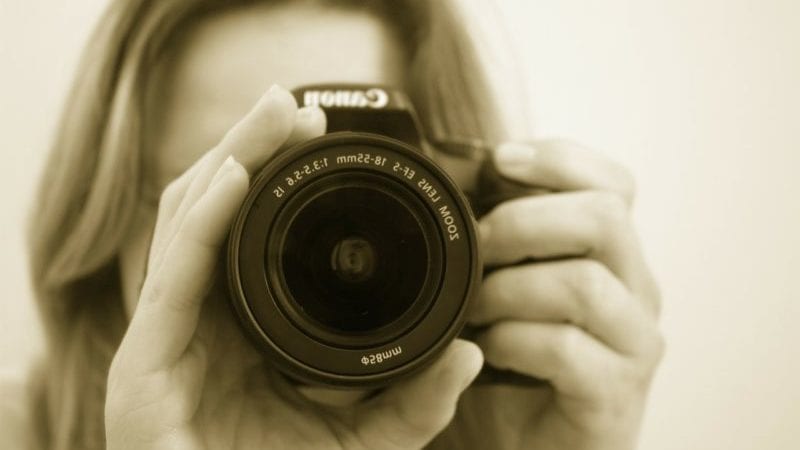
Your students, if they’re anything like mine, love to communicate through images—photos on Instagram , GIFs shared in a text, photo stories on Snapchat. And yet, so much of our conversation in school revolves around words. Understanding text is critical to students’ success now and in the future. But do we also help students identify, read and understand images in order to become literate in the visual language that is all around us? The photo essay can be a great middle or high school assignment that will have strong appeal and grow your students’ writing skills.
What Is a Photo Essay?
For those who aren’t familiar with the term “photo essay,” have no fear. A photo essay, in its simplest form, is a series of pictures that evokes an emotion, presents an idea or helps tell a story. You’ve been exposed to photo essays for your entire life—possibly without even knowing it. For example, you may have seen Dorothea Lange’s Migrant Mother:
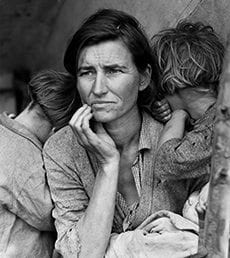
An iconic image of the Great Depression, this picture, along with Lange’s other gripping photos, helped Americans better understand the effects of poverty in California as well as across the nation. Migrant Mother is one of countless photographs that helped persuade, influence or engage viewers in ways that text alone could not.
Photo essays can feature text through articles and descriptions, or they can stand alone with simple captions to give context. The versatility of photo essays has helped the medium become a part of our culture for centuries, from the American Civil War to modern environmental disasters like the 2010 earthquake in Haiti. This versatility is also what makes the photo essay a great educational asset in classrooms today; teachers can use them in any content area. Math students can use them to show a geometric concept in real life. Science students can document a chemistry process at home. Auto students can photograph the technique—and joys and frustrations—of learning a new procedure.
So, where does a teacher begin? Read further for tips and ideas for making photo essays a part of your teaching toolbox.
Start With Photos
Introducing photo essays as a means of changing lives and changing society can hook student interest in the medium. Begin by simply showing pictures and letting students discuss their reactions. Consider this famous photo of the field at Antietam during the Civil War. Share some of the photos from this collection from CNN of 25 of the Most Iconic Photograph s or this list of 50 Influential Photographs That Changed Our World .
Each of these photographs stirs emotion and sends our minds searching for answers. As a warm-up assignment or series of assignments, have students choose (or assign randomly) a photograph to write about. What’s the story? Why did this happen? Who was involved?
DIY Photographs
Before giving a formal photo essay assignment, give students an opportunity to practice and receive feedback. Consider presenting students with several open-ended, ungraded challenges like “For class tomorrow, take a photo that depicts ‘Struggle.’” Other possible photo topics: chaos, frustration, friendship, school. Have students email you their photo homework and share it as a slideshow. Talk about the images. Do they convey the theme?
You can give examples or suggestions; however, giving too many examples and requirements can narrow students’ creativity. The purpose of this trial run is to generate conversation and introduce students to thinking like photographers, so don’t worry if the photos aren’t what you had in mind; it’s about getting feedback on what the student had in mind.
Technique 101
Even though the goal of a photo essay is to influence and create discussion, there is still benefit in giving students a crash course on simple photography concepts. Don’t feel like you have to teach a master-level course on dark-room development. Even a simple overview on the “Rule of Thirds” and the importance of perspective can be enough to help students create intentional, visually stirring photographs.
You can teach these ideas directly or have students do the work by researching on their own. They have most likely seen hundreds of movies, advertisements and photos, so these lessons are simply labeling what they’ve already experienced. Having some knowledge of composition will not only help students improve their visual literacy, it will also help empower them to take photos of their own.
Choose Your Purpose
Are students telling their own stories of their neighborhoods or their families? Are they addressing a social issue or making an argument through their images and text? A photo essay could be a great assignment in science to document a process or focus on nature.
If you are just getting started, start out small: Have students create a short photo essay (two to five images) to present a topic, process or idea you have been focusing on in class. Here’s a Photo Essay Planning Guide to share with your students.
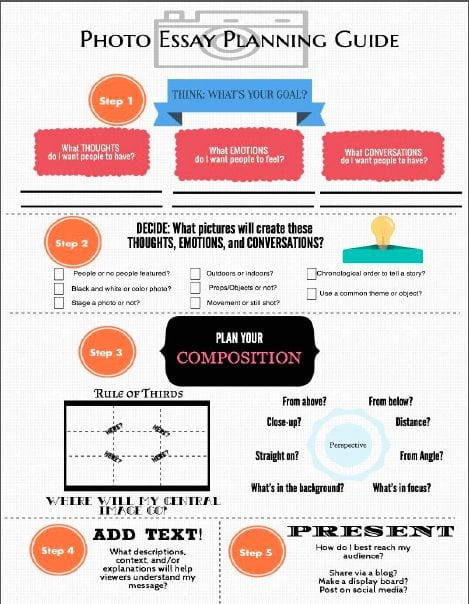
With pictures becoming a dominant medium in our image-filled world, it’s not a question of if we should give students practice and feedback with visual literacy, it’s a question of how . Photo essays are a simple, engaging way to start. So, what’s your plan?
You Might Also Like
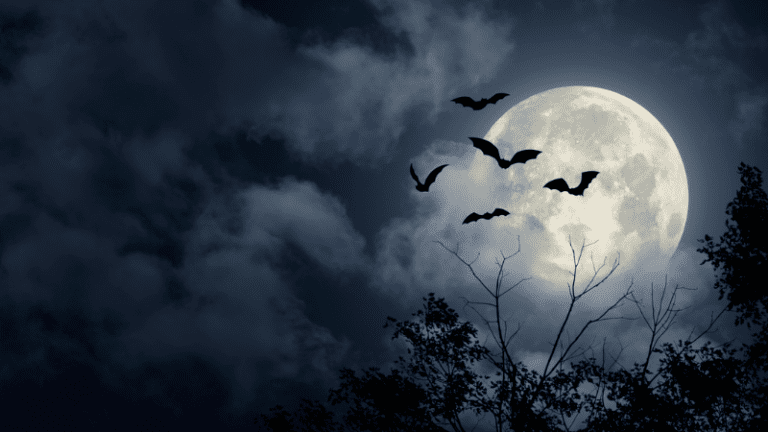
10 Scary Short Stories To Share With Your Students This October
You can't get scared if you read them in the daylight, right? Continue Reading
Copyright © 2023. All rights reserved. 5335 Gate Parkway, Jacksonville, FL 32256

The complete guide about writing a pictorial essay

Post a Comment
Contact form.

How to Write an Image Analysis Essay in 6 Easy Steps
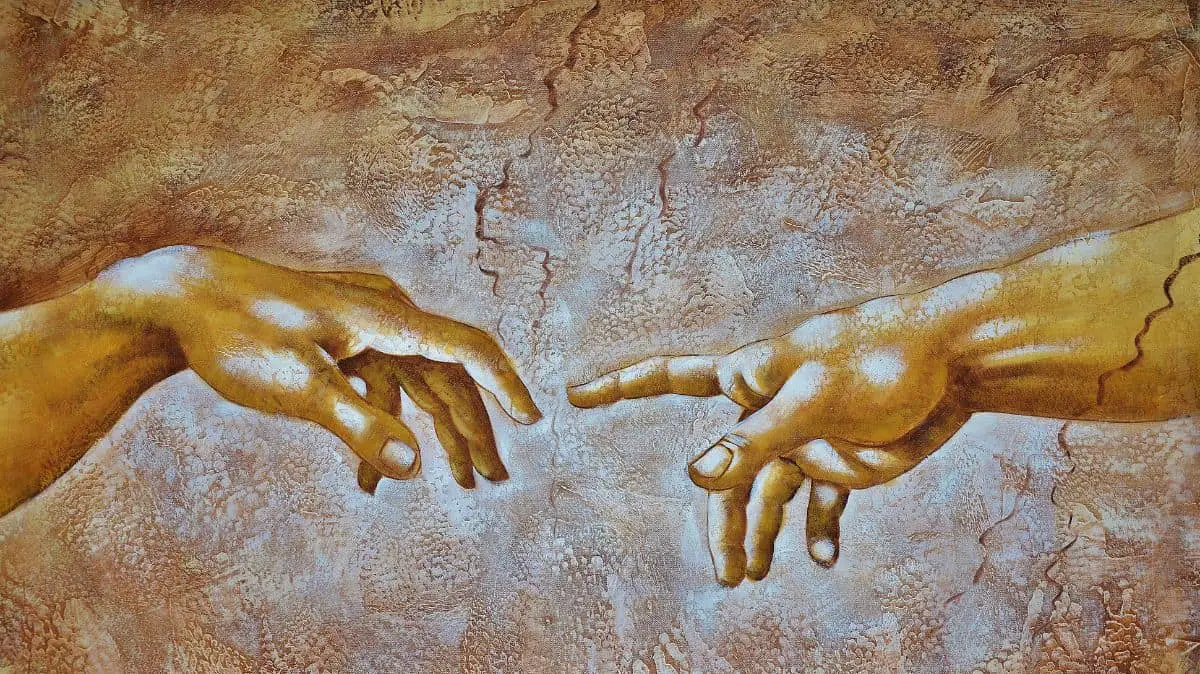
Writing an analysis of a picture can be a little daunting, especially if analyzing and essay writing are not your strengths. Not to worry. In this tutorial, you’ll learn how to do it, even if you’re a beginner.
To write an effective visual analysis, all you need to do is break the image into parts and discuss the relationship between them. That’s it in a nutshell.
Writing an image analysis essay, whether you’re analyzing a photo, painting, or any other kind of an image, is a simple, 6-step process. Let me take you through it.
Together, we’ll analyze a simple image and write a short analysis essay based on it. You can analyze any image, such as a photo or a painting, by following these steps.
Here is a simple image we’ll analyze.

And we’re ready for the…
6 Steps to Writing a Visual Analysis Essay
Step 1: Identify the Elements
When you look at this image, what do you see?
Right now, you are not just a casual observer. You are like a detective who must inspect things thoroughly and be careful not to miss any details.
So, let’s put on our Sherlock Holmes hat, grab a magnifying glass, and make a list of all the major and some minor elements of this picture.
What do we observe?
- Children. How many? Four.
- Children’s hands. Four pairs.
Great. These are all human elements. In fact, it would be useful for us to have two categories of elements: human and non-human.
When we group elements into categories, it will help us later when we’ll be writing the essay. Categories make it easier to think about the elements.
What other elements do we see?
- The hands are holding soil.
- Each handful of soil also has a tiny plant in it.
- Finally, we see the green lawn or ground on which the children stand.
These are all of the obvious elements in the image. But can we dig deeper and observe more?
Again, wearing our Sherlock Holmes hat, our job is to gather information that may not be immediately obvious or noticeable.
Let’s take another look, using our detective tentacles:
- The children’s hands are arranged in a circle.
- The children’s skin color varies from lighter to darker.
- The children wear summer clothes.
You may have noticed these elements even when you first saw the image. In that case, great job!
It looks like we’ve covered all the elements. We’re ready to move on to the next step.
Step 2. Detect Symbols and Connections
What does Sherlock Holmes or any good detective do after basic observation? It is time to think and use our logic and imagination.
We will now look for symbols and any connections or relationships among the elements.
Identifying Symbols
- Children symbolize future and hope.
- Their hands form a circle, creating a unifying effect. The symbol is unity, and there is power in unity.
- Children’s hands hold soil, and soil symbolizes earth, perhaps planet Earth.
- The earth holds young plants which symbolize the environment and ecology.
- The young plants also symbolize youth and the future.
- The children wear summer clothes, and summer symbolizes happiness and freedom because this is when children are on vacation and enjoy life.
Great. Now, let’s see if we can make some connections and identify some relationships among the elements and symbols.
We will use our imagination to put together some kind of a meaning.
In analyzing an image, we want to understand what the creator or the artist is trying to convey.
Do artists and photographers always want to convey something or is it sometimes just a picture?
It doesn’t matter because we never know what the artist really thought when creating the work . We’re not mind readers.
But we can always gather meaning using our own logic and imagination. We can derive meaning from any image. And that’s all we need to do to write an analysis essay.
Finding Connections and Relationships
Let’s allow our imagination to roam free and write down a few thoughts. Some ideas will be more obvious than others.
- This entire image seems to be about the future of the environment.
- Why is this future important? It’s important because of the future generations, symbolized by the children.
- A strong sense of long-term future is conveyed because not only do the children hold plants, but these are baby plants. The message is “children hold future generations.”
- The variety of skin colors implies diversity. Also, the hands form a circle. Together, these two elements can mean: “global diversity.”
As you can see, we can derive really interesting meaning from even a simple image.
We did a great job here and now have plenty of material to work with and write about. It’s time for the next step.
Step 3. Formulate Your Thesis
In this step, your task is to put together an argument that you will support in your essay. What can this argument be?
The goal of writing a visual analysis is to arrive at the meaning of the image and to reveal it to the reader.
We just finished the analysis by breaking the image down into parts. As a result, we have a pretty good idea of the meaning of the image.
Now, we need to take these parts and put them together into a meaningful statement. This statement will be our thesis.
Let’s do it.
Writing the Thesis
This whole picture may mean something like the following:
This sounds good. Let’s write another version:
This sounds good, as well. What is the difference between the two statements?
The first one places the responsibility for the future of the planet on children.
The second one places this responsibility on the entire humanity.
Therefore, the second statement just makes more sense. Based on it, let’s write our thesis.
We now have our thesis, which means we know exactly what argument we will be supporting in the essay.
Step 4: Write the Complete Thesis Statement
While a thesis is our main point, a thesis statement is a complete paragraph that includes the supporting points.
To write it, we’ll use the Power of Three. This means that we are going to come up with three supporting points for our main point.
This is where our categories from Step 1 will come in handy. These categories are human and non-human elements. They will make up the first two supporting points for the thesis.
The third supporting point can be the relationships among the elements.
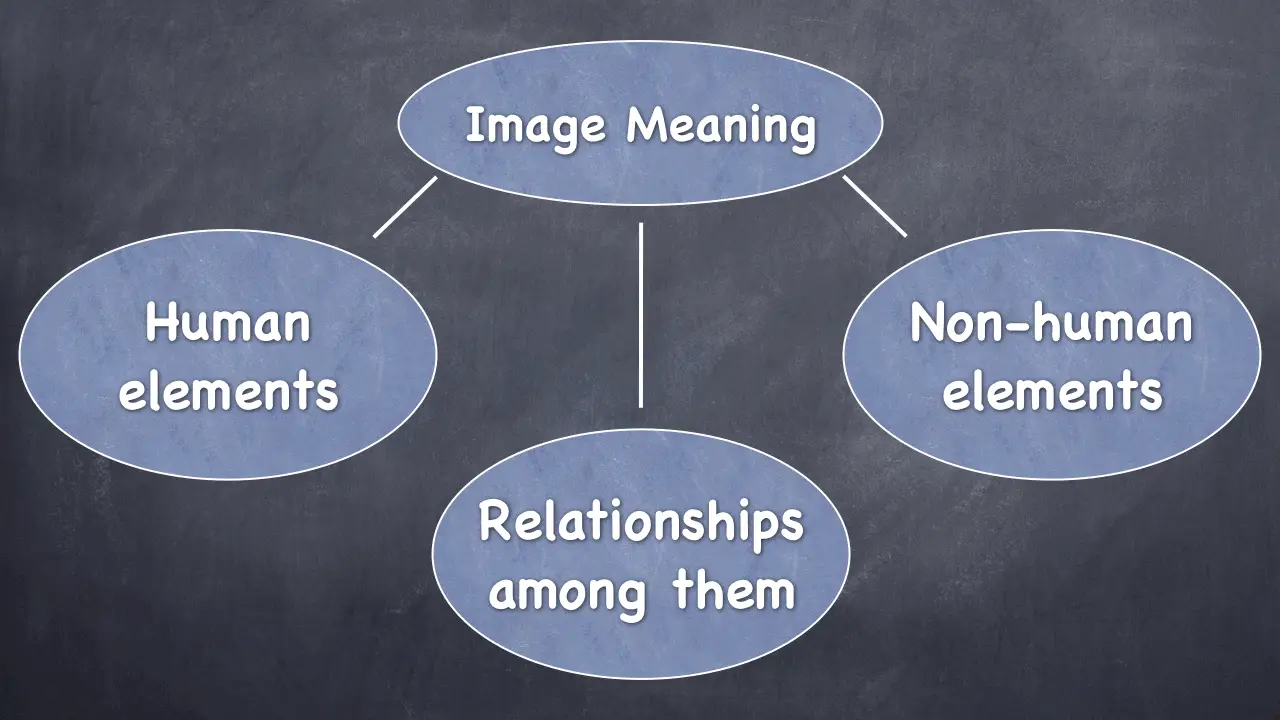
We can also pick a different set of supporting points. Our job here is to simply have three supporting ideas that make sense to us.
For example, we have our elements, symbols, and connections. And we can structure the complete argument this way:
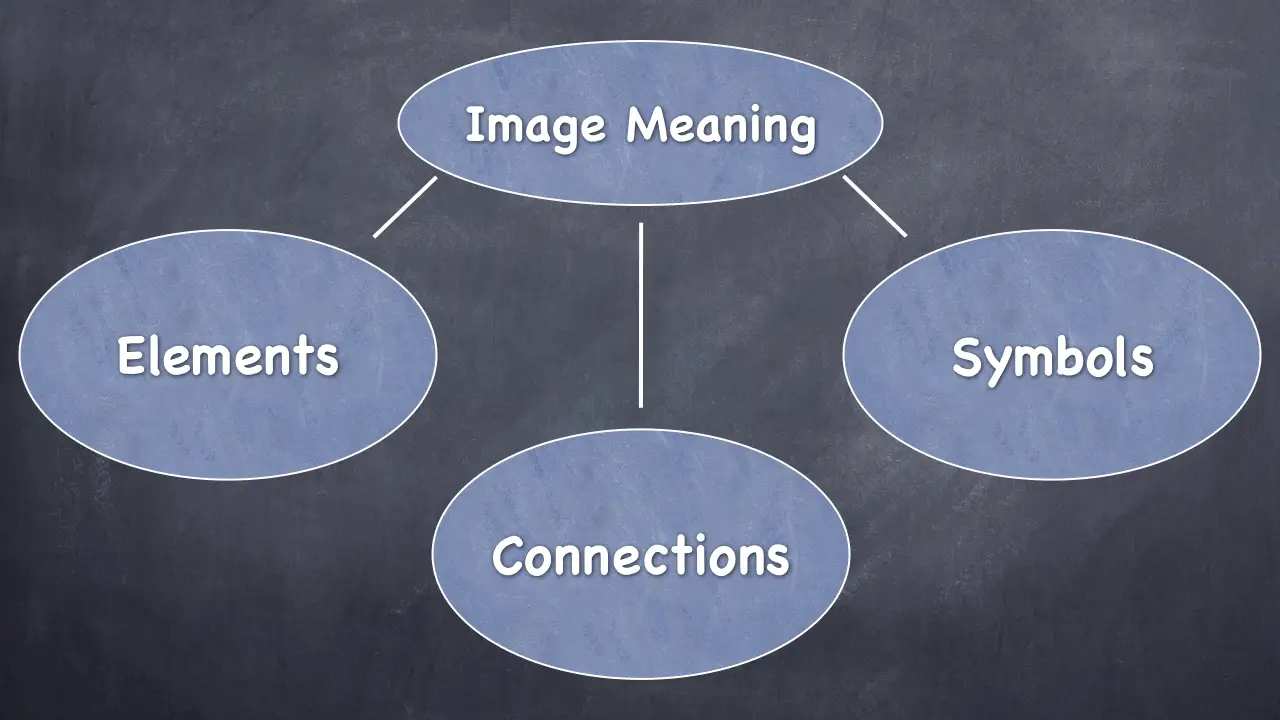
All we really need is one way to organize our thoughts in the essay. Let’s go with the first version and formulate the supporting points.
Here’s our main point again:
Here are our supporting points:
- The photographer uses the image of children to symbolize the future.
- The non-human elements in the photo symbolize life and planet Earth.
- The author connects many ideas represented by images to get the message across.
Now we have everything we need to write the complete thesis statement. We’ll just put the main and the supporting statements into one paragraph.
Thesis Statement
Step 5: write the body of your essay.
At this point, we have everything we need to write the rest of the essay. We know that it will have three main sections because the thesis statement is also our outline.
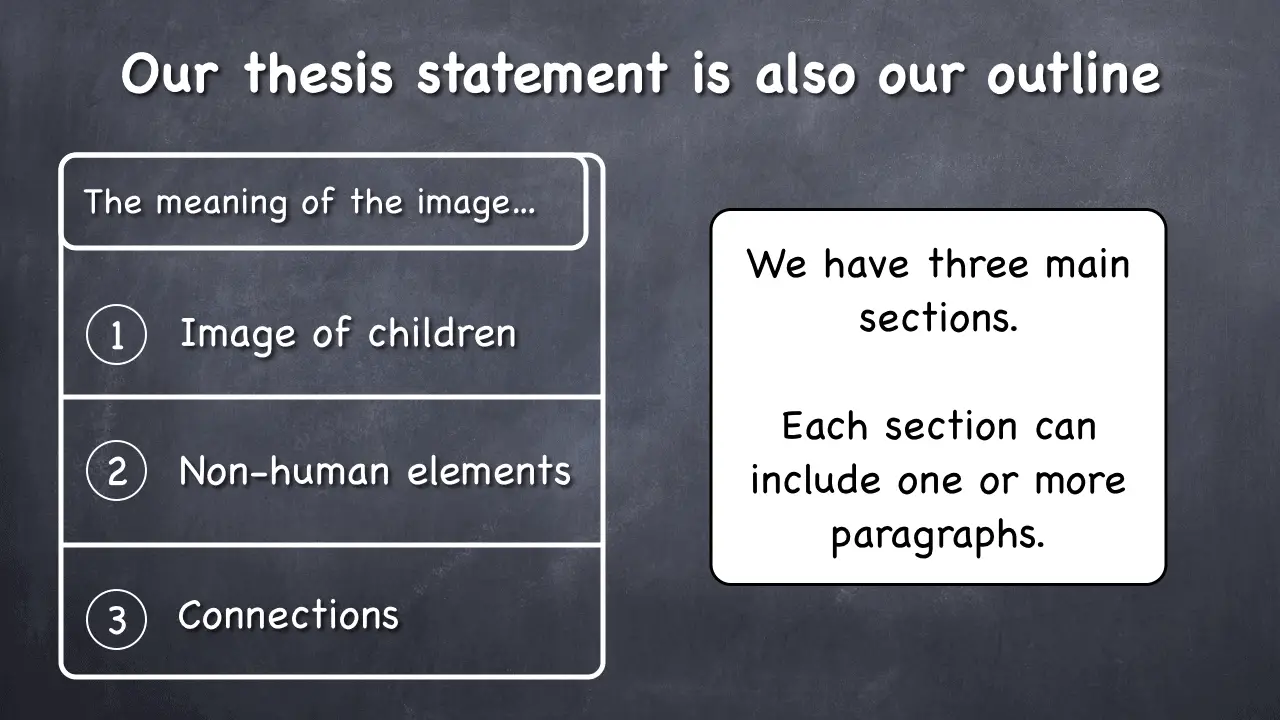
We’re ready to write the body of the essay. Let’s do it.
Body of the Essay (3 paragraphs)
“The author of this photograph chose children and, more specifically, children’s hands in order to convey his point. In many, if not all human cultures, children evoke the feelings of hope, new beginnings, and the future. This is why people often say, ‘Children are our future.’ Furthermore, the children in the photo are of different ethnic backgrounds. This is evident from their skin colors, which vary from lighter to darker. This detail shows that the author probably meant children all over the world.
The non-human elements of the picture are the plants and the soil. The plants are very young – they are just sprouts, and that signifies the fragility of life. The soil in which they grow evokes the image of our planet Earth. Soil also symbolizes fertility. The clothes the children wear are summer clothes, and summer signifies freedom because this is the time of a long vacation for school children. Perhaps the author implies that the environment affects people’s freedom.
Finally, the relationships and connections among these elements help the photographer convey the message that humans should be mindful of their decisions today to ensure a bright future for the planet. This idea can be arrived at by careful examination. First, the children’s hands are arranged in a circle, which is a symbol of our planet and also signifies the power of unity. The future depends on people’s cooperation. Second, the children seem to be in the process of planting. The author emphasizes long-term future because the children hold baby plants. In other words, they ‘hold the future of other children’ in their hands. Third, the placement of the sprouts, which rest inside the soil in children’s hands, is a strong way to suggest that the future of the ecology is literally ‘in our hands.’”
Step 6. Add an Introduction and a Conclusion
Before we continue, I have an entire detailed article on how to write an essay step-by-step for beginners . In it, I walk you through writing every part of an essay, from the thesis to the conclusion.
Introduction
That said, your introduction should be just a sentence or two that go right before you state the thesis.
Let’s revisit our thesis statement, and then write the introduction.
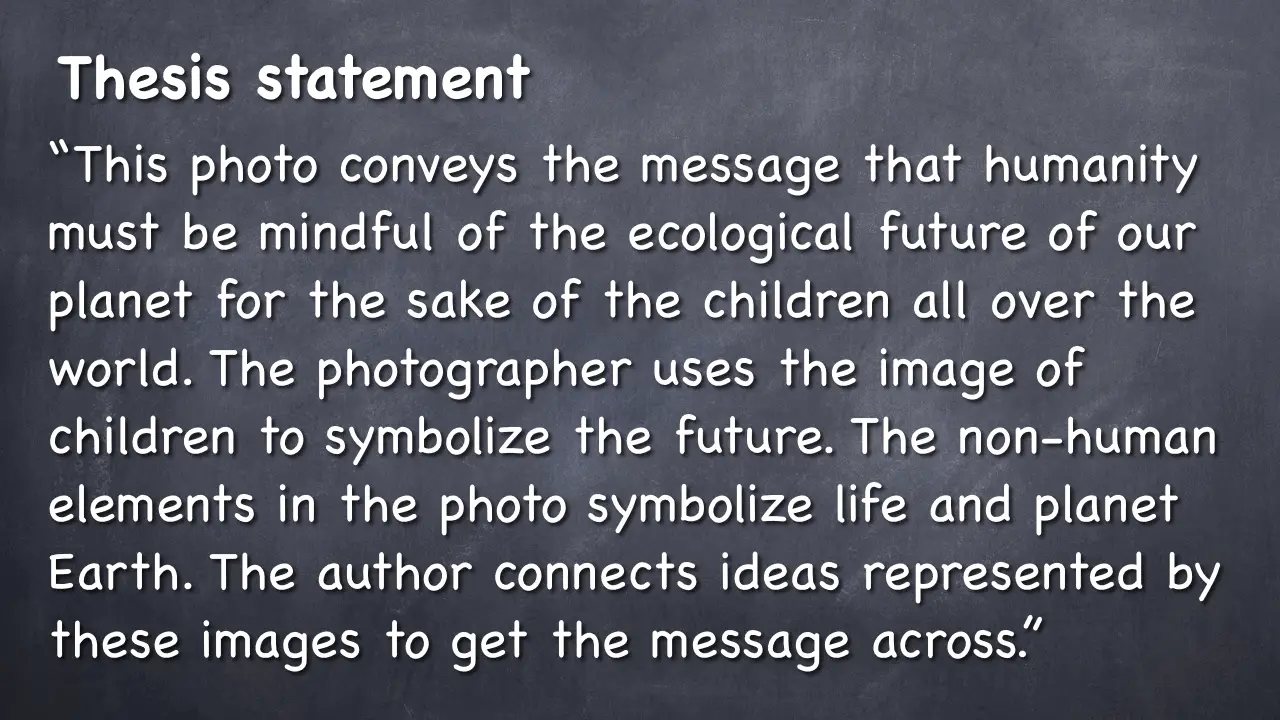
And now let’s write an introductory sentence that would make the opening paragraph complete:
Now, if you read this intro sentence followed by the thesis statement, you’ll see that they work great together. And we’re done with the opening paragraph.
Your conclusion should be just a simple restatement. You can conclude your essay in many ways, but this is the basic and time-proven one.
Let’s do it:
We simply restated our thesis here. Your conclusion can be one or more sentences. In a short essay, a sentence will suffice.
Guess what – we just wrote a visual analysis essay together, and now you have a pretty good idea of how to write one.
Hope this was helpful!
How to Write a 300 Word Essay – Simple Tutorial
How to expand an essay – 4 tips to increase the word count, 10 solid essay writing tips to help you improve quickly, essay writing for beginners: 6-step guide with examples, 6 simple ways to improve sentence structure in your essays.
Tutor Phil is an e-learning professional who helps adult learners finish their degrees by teaching them academic writing skills.
You Might Like These Next...
How to Write a Summary of an Article in 5 Easy Steps
https://youtu.be/mXGNf8JMY4Y When you’re summarizing, you’re simply trying to express something in fewer words. I’m Tutor Phil, and in this tutorial, I’ll show you how to summarize an...
How to Write Strong Body Paragraphs in an Essay
https://youtu.be/OcI9NKg_cEk A body paragraph in an essay consists of three parts: topic sentence, explanation, and one or more examples. The topic sentence summarizes your paragraph completely...
Jump to navigation
- Inside Writing
- Teacher's Guides
- Student Models
- Writing Topics
- Minilessons
- Shopping Cart
- Inside Grammar
- Grammar Adventures
- CCSS Correlations
- Infographics
Get a free Grammar Adventure! Choose a single Adventure and add coupon code ADVENTURE during checkout. (All-Adventure licenses aren’t included.)
Sign up or login to use the bookmarking feature.
- 33 Writing Photo Essays
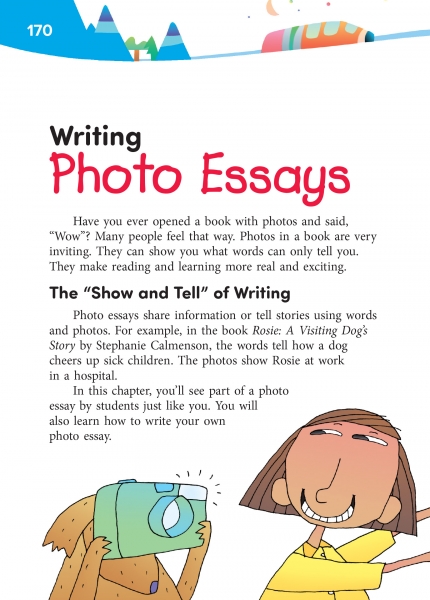
Start-Up Activity
Share appropriate magazines that include photos and text, such as National Geographic or Life . Have students page through the magazines, looking for photos that draw their attention. Ask what they like about the photos. Ask what they can learn from the photos. Ask them to close their eyes and imagine the magazine with no photos, just words.
Lead a discussion about the power of pictures. Help students understand that when they connect words and photos, they can reach their audience in all new ways.
Think About It
“We try to grab pieces of our lives as they speed past us. Photographs freeze those pieces and help us remember how we were.”
—Gene McSweeney
State Standards Covered in This Chapter
- CCSS.ELA-LITERACY.RI.6.1
- CCSS.ELA-LITERACY.RI.6.2
- CCSS.ELA-LITERACY.RI.6.3
- CCSS.ELA-LITERACY.RI.6.7
- CCSS.ELA-LITERACY.W.6.2
- CCSS.ELA-LITERACY.W.6.2.A
- CCSS.ELA-LITERACY.W.6.2.B
- CCSS.ELA-LITERACY.W.6.4
- CCSS.ELA-LITERACY.W.6.5
- CCSS.ELA-LITERACY.W.6.7
- CCSS.ELA-LITERACY.W.6.2.C
- CCSS.ELA-LITERACY.W.6.2.D
- CCSS.ELA-LITERACY.W.6.2.E
- CCSS.ELA-LITERACY.W.6.2.F
- CCSS.ELA-LITERACY.W.6.6
LAFS Covered in This Chapter
Lafs.6.ri.1.1, lafs.6.ri.1.2, lafs.6.ri.1.3, lafs.6.ri.3.7, lafs.6.w.1.2, lafs.6.w.2.4, lafs.6.w.2.5, lafs.6.w.3.7, lafs.6.w.2.6, teks covered in this chapter, 110.22.b.5.f, 110.22.b.8.d, 110.22.b.8.d.i, 110.22.b.6.d, 110.22.b.8.d.iii, 110.22.b.8.f, 110.22.b.10, 110.22.b.11.b, 110.22.b.10.a, 110.22.b.10.b.i, 110.22.b.10.b.ii, 110.22.b.10.b, 110.22.b.10.c, 110.22.b.10.d, 110.22.b.12, 110.22.b.10.e, page 171 from write on track, sample photo essay.
Have volunteers read each paragraph of the sample photo essay. When a photo accompanies a paragraph, stop to discuss the photo. "How does the photo make the ideas clearer?" "What is the photo doing that the text can't do?" Point out to students that each photo must be carefully chosen and positioned, just as the words are carefully chosen and positioned.
Related Resource Tags
Click to view a list of tags that tie into other resources on our site
Page 172 from Write on Track
Ask for a student volunteer to read the paragraph in the middle of the photo essay.
Then ask for other volunteers to describe "what the photo shows you." Help students understand that they can learn a great deal from a photo.
Page 173 from Write on Track
Have a volunteer read the paragraph. Then lead a discussion about what they see. Ask students what the photos are doing that words alone can't do.
Then have a volunteer read the last part of the essay.
Page 174 from Write on Track
Writing a photo essay.
Have your students list interesting people they know who have jobs or hobbies that other students would like to find out about. Students then should pick a topic.
Lead students through the next two sets of tips, having them research their topics and collect photos. If they know the person, they may want to interview him or her and take pictures. If they don't know the person, they may need to do research in books and online.
At the bottom of the page, remind students that the photos they include shouldn't just be "for show." They should communicate ideas that words can't express.
Page 175 from Write on Track
Writing, revising, and editing.
After students have gathered information and images for their photo essays, lead them through "Writing a Draft." Then give them time to put their first drafts together.
When the time comes to revise, have students use the questions under "Revising" to improve their work. Also, have peer readers use these questions to suggest improvements.
After revising, have students check for spelling, capitalization, and punctuation errors.
- 01 Understanding Writing
- 02 One Writer's Process
- 03 Qualities of Writing
- 04 Selecting a Topic
- 05 Collecting Details
- 06 Writing a First Draft
- 07 Revising and Editing
- 08 Publishing Your Writing
- 09 Writing Basic Sentences
- 10 Combining Sentences
- 11 Writing Paragraphs
- 12 Understanding Text Structures
- 13 Writing in Journals and Logs
- 14 Writing Lists
- 15 Making Albums
- 16 Writing Notes and Emails
- 17 Writing Friendly Letters
- 18 Writing Personal Narratives
- 19 Writing Family Stories
- 20 Writing Realistic Stories
- 21 Writing Time-Travel Fantasies
- 22 Writing Tall Tales
- 23 Writing Alphabet Books
- 24 How-To Writing
- 25 Writing Information Essays
- 26 Writing Newspaper Stories
- 27 Writing Persuasive Essays
- 28 Writing Opinion Letters
- 29 Writing Book Reviews
- 30 Making Bookmarks
- 31 Writing Classroom Reports
- 32 Writing Summaries
- 34 Writing Free-Verse Poetry
- 35 Traditional and Playful Poetry
- 36 Writing Plays
- 37 Using the Library
- 38 Using Technology
- 39 Reading to Understand Fiction
- 40 Reading to Understand Nonfiction
- 41 Reading Graphics
- 42 Reading New Words
- 43 Building Vocabulary Skills
- 44 Using Prefixes, Suffixes, Roots
- 45 Becoming a Better Speller
- 46 Learning to View
- 47 Giving Speeches
- 48 Performing Poems
- 49 Telling Stories
- 50 Learning to Interview
- 51 Listening to Learn
- 52 Using Graphic Organizers
- 53 Thinking Clearly
- 54 Thinking Creatively
- 55 Completing Assignments
- 56 Working in Groups
- 57 Taking Tests
- 58 Proofreader's Guide
- 59 Student Almanac
Writing a pictorial essay
Affiliation.
- 1 Singapore Medical Journal, 2 College Road, Singapore 169850. [email protected]
- PMID: 20428738
A pictorial essay is a type of educational article that aims to provide both textual and visual portrayals of a topical issue. It usually consists of a short unstructured abstract, brief introduction, subheadings to organise the material and a summary. The number of references is limited to a few key articles, typically, eight to 15, or fewer. The text is usually short, often approximately 1,000 to 2,000 words in length, with much of the message contained in the figure legends. This type of article allows for a large number of figures, typically up to 20 figures or 30 figure parts. The main criteria for publication are currency, educational value and high quality of illustrations.
- Biomedical Research
- Journalism, Medical*
- Photography*
- Publishing*
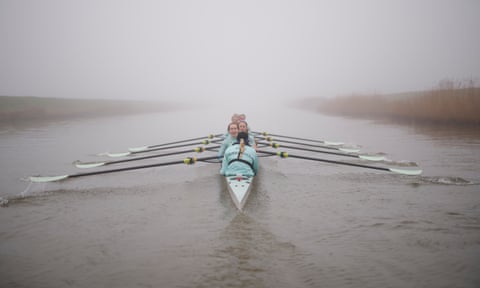
Pulling together: how Cambridge came to dominate the Boat Race – a photo essay
The race along the River Thames between England’s two greatest universities spans 195 years of rivalry and is now one of the world’s oldest and most famous amateur sporting events. Our photographer has been spending time with the Cambridge University Boat Club over the past few months as they prepare for 2024’s races
T he idea of a Boat Race between the two universities dates back to 1829, sparked into life by a conversation between Old Harrovian schoolfriends Charles Merivale, a student at the time at St John’s College Cambridge, and Charles Wordsworth who was at Christ Church Oxford. On 12 March that year, following a meeting of the newly formed Cambridge University Boat Club, a letter was sent to Oxford.
The University of Cambridge hereby challenge the University of Oxford to row a match at or near London each in an eight-oar boat during the Easter vacation.
From then, the Cambridge University Boat Club has existed to win just one race against just one opponent, something Cambridge has got very good at recently. Last year the Light Blues won every race: the open-weight men’s and women’s races, both reserve races, plus both lightweight races – six victories, no losses, an unprecedented clean sweep. Cambridge women’s open-weight boat, or blue boat, has won the last six Boat Races while the men’s equivalent have won five out of the last seven. In such an unpredictable race, where external factors can play a large part, this dominance is startling.

Thames trials
Rough water as the two women’s boats make their way along the River Thames near Putney Embankment during the Cambridge University Boat Race trials.
It’s a mid-December day by the River Thames. The sky and water merge together in a uniform battleship grey and the bitter north wind whips the tops off the waves. Outside a Putney boathouse two groups of tense-looking women dressed in duck-egg blue tops and black leggings with festive antlers in their hair are huddling together, perhaps for warmth, maybe for solidarity. The odd nervous bout of laughter breaks out. For some of them this is about to be their first experience of rowing on the Tideway, a baptism of fire on the famous stretch of London water where the Boat Race takes place. “Perfect conditions,” remarks Paddy Ryan, the head coach for Cambridge University women, for this is trial eights day, when friends in different boats duel for coveted spots in the top boat.
A couple of hours later these women along with their male equivalents will have pushed themselves to the absolute limit, so much so that several of the men are seen trying to throw up over the side of their boats at the finish under Chiswick Bridge. This may be brutal but it’s just the start. For these students the next few months are going to be incredibly tough, balancing academic work with training like a professional athlete. Through the harshest months of the year they will be focused on preparing for the end of March and a very simple goal: beating Oxford in the Boat Race.
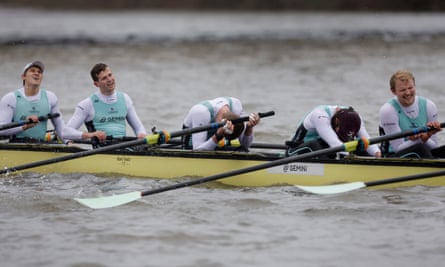
Agony for one of the men’s boats after the finish of the race near Chiswick Bridge during the Cambridge University Boat Race trials.

Ely early mornings
Two of the women’s boats head out in the early morning for a training session on the Great Ouse.
Early winter mornings on the banks of the Great Ouse, well before the sun has risen, can be pretty bleak. In the pitch black a batch of light blue minivans drop off the men and women rowers together at the sleek Ely boathouse that was opened in 2016 at the cost of £4.9m – it’s here that all Cambridge’s on-water training takes place. Very soon a fleet of boats carrying all the teams takes to the water for a training session that may last a couple of hours. Then it’s a quick change, a lift to the train station and back to Cambridge for morning lectures.

The women’s squad head into the Ely boathouse after a 6am drop-off.
As a rower descends the stairs to the bays where the boats are stored, there is a clear indication of why it was built and why they are there. “This is where we prepare to win Boat Races,” a sign says. Since this boathouse was built, Cambridge have won 30 of the 37 races across all categories.
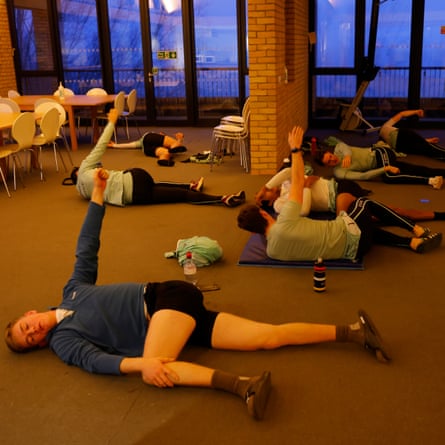
Top: The men’s squad stretch in the boathouse before an early morning training session and a member of the men’s blue boat descends the stairs into where the boats are kept. Below: One of the men’s teams set off for early morning training and the women’s blue boat rows past the women’s lightweight crew during a training session.
It’s a far cry from the old tin sheds with barely any heating and no showers. These current facilities are impressive, enabling the entire men’s and women’s squads to be there at the same time and get boats out.
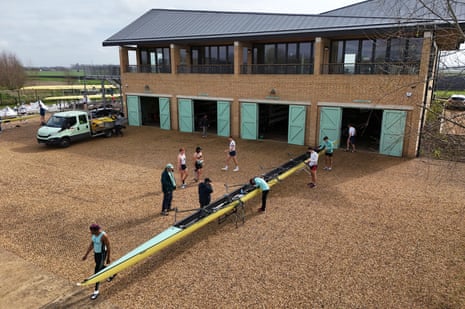
Top: The men’s blue boat prepare to derig their boat at their Ely training site. Above: The women’s blue boat put their vessel back in the boathouse after a training session on the Great Ouse.
But it’s not just the boathouse that has contributed so much, it’s also the stretch of water they train on. In a year when floods have affected so many parts of the country it has really come into its own. Paddy Ryan, the chief women’s coach, explains: “Along this stretch the river is actually higher than the surrounding land. The water levels are carefully managed by dikes and pumps. As a result we haven’t lost a single session to flooding. That’s not the case for Oxford. I believe their boathouse has been flooded multiple times this year, unable to get to their boats. We’ve had multiple storms but we’ve been able to row through them all.”

The men’s third boat practises on the Great Ouse.
It’s a flat, unforgiving landscape, especially in midwinter, definitely not the prettiest stretch of water, but Cambridge don’t care. Ryan says: “It might be a little dull on the viewing perspective but we could row on for 27km before needing to turn round. We have a 5km stretch that is marked out every 250m. We are lucky to have it.”

The men’s blue boat practise their starts on the long straight on the Great Ouse.

The sweat box
Members of the men’s squad check on their technique with the use of a mirror at the Goldie boathouse.
The old-fashioned Goldie boathouse is right in the centre of Cambridge perched on the banks of the River Cam. Built in 1873, its delicate exterior belies what goes on inside. This is the boat club’s pain cave, where the rowers sweat buckets, pushing themselves over and over again; it’s a good job the floor is rubberised and easy to wipe clean.
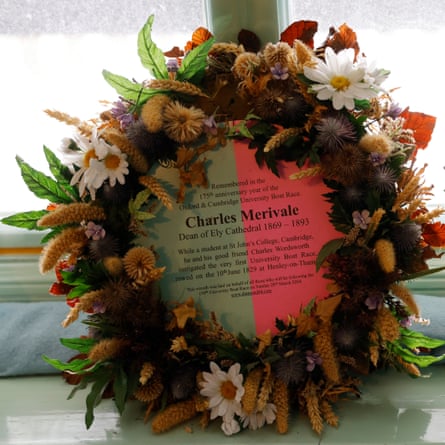
A wreath to Charles Merivale, the founder of the Boat Race, and wood panelling in the upstairs room at the Goldie boathouse which commemorates Cambridge crews that have competed in the Boat Race from 1829.

(Top) Seb Benzecry, men’s president of the Cambridge University Boat Club, and (above) Martin Amethier, a member of the reserve Goldie crew, sweat during sessions on ergo machines.

Iris Powell of the women’s blue boat (above) performs pull-ups during a training session.

Above left: Hannah Murphy, the cox of the women’s blue boat, urges on four of her crew (left to right) Gemma King, Megan Lee, Jenna Armstrong and Clare Hole, as they undertake a long session on the ergo machines. Above right: Kenny Coplan, a member of the men’s blue boat crew, looks exhausted then writes in his times after his session on an ergo machine (below).
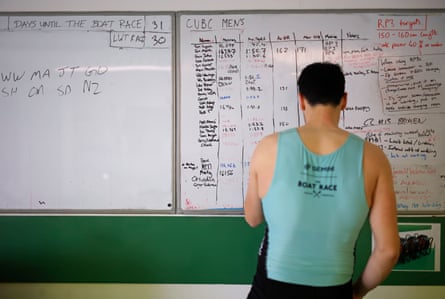
Brutal sessions on the various ergo machines, where thousands of metres are clocked and recorded, are a staple of the training regime set in place. If there is any slacking off the students just need to look up at one of the walls where a map of the Boat Race course hangs. The “S” shape of the Thames has been carefully coloured in the correct shade of blue and record timings for various key points on the course have been written in for both men and women. All but one record, and that one is shared, is held by Cambridge.

Paddy Ryan, the women’s chief coach, talks to the women’s blue boat during a training session on the River Great Ouse in February.
A key ingredient in any successful team is the coaching. Cambridge’s setup is stable and well established. Paddy Ryan is the chief women’s coach, a genial, tall Australian, he has been part of the women’s coaching team since 2013. The care and devotion to his squad is perfectly clear. “I have my notebook next to my bed so I can jot things down. I wake up in the middle of the night going: am I making the right decisions? I care about them as people and I need to manage them … We joke as coaches that we are teaching some of the smartest people on the planet how to pull on a stick.”
Rob Baker, the chief men’s coach, has Cambridge rowing in the blood. Born and bred in the city, his father was a university boatman for 25 years. He even married into the sport – his wife, Hayley, rowed for Cambridge as a lightweight – so it was no surprise that he became part of the coaching setup way back in 2001. He was the first full-time women’s coach in 2015 then moved to take over the men in 2018.
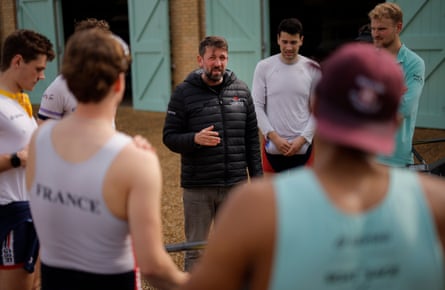
Rob Baker, the men’s chief coach, talks to his blue boat at their Ely training site.
Apart from an obvious role in the development of rowing skills, a key part of their job is making sure there is a balance for their student athletes. They understand they have to juggle training needs. “Every week we have a general plan,” says Baker, “but then someone might have an extra class or supervision they’ve got to do so we have to move around it. They are studying at one of the most competitive universities in the world with the highest standards so you’ve got to give them space to do that properly.” He goes on: “But when they get on the start line for their race, they’ll be just as competitive as if they were professionals.”
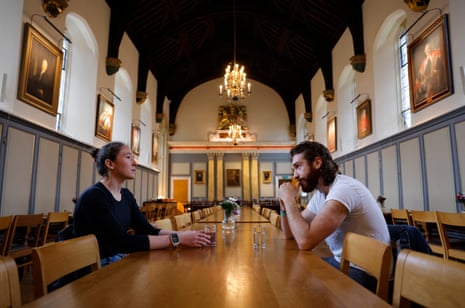
The presidents
Jenna Armstrong and Seb Benzecry discuss their plans in the Great Hall at Jesus College.
Every year one man and one woman are elected presidents to represent Cambridge University Boat Club. They are the captains and leaders, not only responsible for helping design the training programme in conjunction with the coaches but also making budgetary and tactical decisions along the way. This year both of them, Jenna Armstrong and Seb Benzecry, are from the same college, Jesus, which helps the communication between the two of them. They share ideas and knowledge, thoughts and worries. Their lives, for these intense few months, are a juggling act.
Armstrong is a 30-year-old from New Jersey, and doing a PhD in physiology. Once a very keen competitive junior skier she was forced to abandon her hopes of a career on the slopes after a number of serious knee injuries. She only started rowing in 2011 and only became aware of the Boat Race when she saw it on TV a couple of years later.
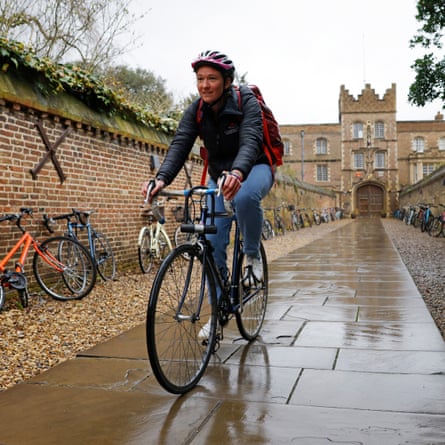
Jenna Armstrong, cycling down the Chimney, the grand entrance to Jesus College, to go to the other side of the city to carry out more of her PhD research at the department of physiology, development and neuroscience.
The research she carries out at the university labs could be turn out to be life-saving. “I study mitochondrial function in placentas from women from all over the world to learn how genetic and environmental factors during pregnancy can influence placental metabolism and impact the health of both mother and baby. I’m particularly interested in growth restriction which affects about 10% of babies worldwide. That can have lifelong implications for these babies and currently we don’t have any treatment for this.”
Benzecry, 27, is studying for a PhD in film and screen studies, and comes from a completely different rowing background. He grew up just a stone’s throw from the Boat Race course and went to a school on the banks of the Thames. This will be his 14th year of competitive rowing but his fourth and last Boat Race.
“ I remember one year my birthday fell on race day and we watched after my birthday party. Because we live fairly close to the course, I’ve always felt connected to the race.”

Seb Benzecry stands next to an Antony Gormley statue in the Quincentenary Library at Jesus College as he conducts research for his dissertation which forms part of his PhD in film and screen studies.
Talking about how hard it is to get the right balance between academic student life and rowing, Benzecry says: “I guess you have to accept there are many, many things you can’t do, you just don’t have time for during the season. You have to put the blinkers on.”
Armstrong says: “I have to be very prepared, very strategic and organised. I pack everything the night before, and then once I leave my room in the morning, I don’t go back. That allows me to go to training, go to the lab, go to training again. It’s surreal actually, to come to a place like Cambridge, have one of the best educations in the world on top of the most incredible rowing experiences in the world. We have a thing now in the boat, when we are doing something incredibly hard, I say this is my ideal Saturday, I wouldn’t want to be anywhere else. I would rather be here than in bed or on a date. And I make everyone else say it with me too. I’d rather be nowhere else.”
Benzecry states: “When it’s really bad, when training is so hard, we say Oxford aren’t doing this, they could never do this. It’s an incredibly powerful thing to be thinking we work harder than them, our culture is better than them. They don’t want to go hard as we do – they might think they do but they don’t, they just don’t have it.”
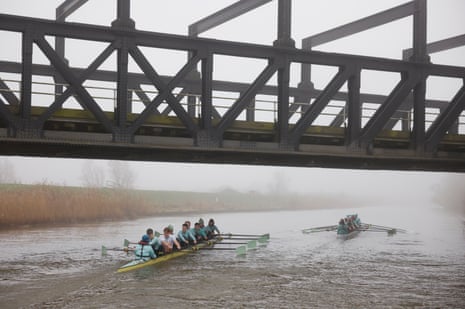
Integration
The men’s and women’s blue boats during a training session on the River Great Ouse in February.
Until 1 August 2020, there were three separate university boat clubs in Cambridge: one for open-weight men, one for lightweight men, and one for open-weight and lightweight women. Since they merged to become one club, it has undoubtedly helped with everyone sharing the same resources and motivating and inspiring one another. No one is more important and everyone has a key part to play in the result. This year, Oxford have followed suit.
Baker says: “I definitely feel, for the athletes themselves, it makes a big difference. They all feel like they’re contributing to one common goal. Every cog in the wheel has to do its job but for sure it feels like one big team on a mission.”
Benzecry explains: “We’re seeing each other train, we’re all out on the water at the same time, we’re supporting each other throughout the season, building a sense of momentum for the whole club towards the races. Everyone’s just inspiring each other all the time and I think that’s been such a sort of cultural shift for Cambridge.”
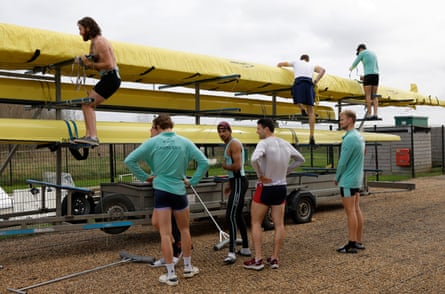
The men’s blue boat pack their craft on to a trailer at their Ely training site ready for the trip down to London for the Boat Race.
Siobhan Cassidy, the chair of the Boat Race, knows from first-hand how the integration has helped. She rowed for the Light Blues in 1995 and had a key role in the transition. “We could see the advantages of working together, collaborating as a bigger team, the positive impact we felt that could have on performance. But not just the output, actually the whole experience for the young people taking part.”

Siobhan Cassidy, the chair of the Boat Race, pictured at the Thames Rowing Club at Putney Embankment.
This Saturday, if the weather holds, an estimated 250,000 people, the vast majority of whom have no allegiance to one shade of blue or the other, will pack the banks of the Thames to see these races. It’s one of the largest free events in Britain. Broadcast live on BBC One, the race is also beamed to 200 countries across the world.
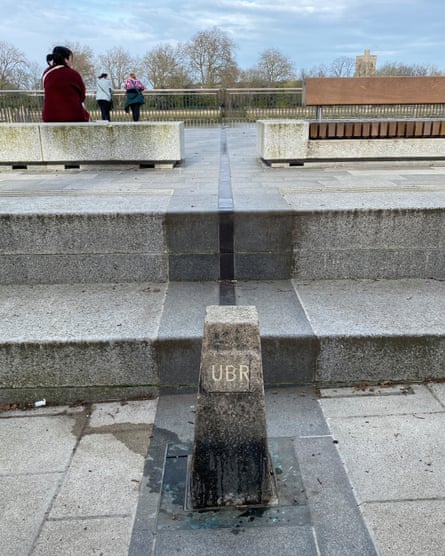
The starting stone for the University Boat Race and pavement inscription: “The best leveller is the river we have in common” at Putney Embankment.
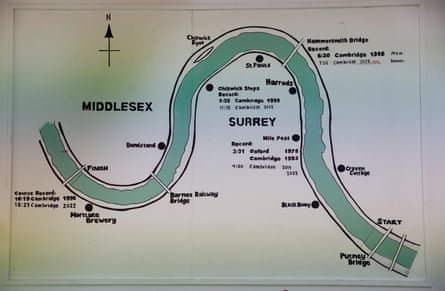
A map of the Boat Race course at the Goldie boathouse, with the Thames coloured in Cambridge blue and record timings written in for men and women showing almost total Cambridge dominance.
A sporting pinnacle being contested on a fast-flowing, unpredictable river by two teams of university students – it’s pretty bizarre. But maybe it’s that quirkiness that keeps the race, after almost two hundred years, still going strong. And even more bizarre to think that Cambridge, the current dominant force in the Boat Race, a sporting event that can’t shrug off its elitist stereotype, owes so much of that success to such egalitarian principles.
- The Guardian picture essay
- The Boat Race
- University of Cambridge
- Photography
Most viewed
- Share full article
Advertisement
Supported by
Guest Essay
Scientists Just Gave Humanity an Overdue Reality Check. The World Will Be Better for It.

By Stephen Lezak
Mr. Lezak is a researcher at the University of Cambridge and the University of Oxford who studies the politics of climate change.
The world’s leading institution on geology declined a proposal on Wednesday to confirm that the planet has entered a new geologic epoch , doubling down on its bombshell announcement earlier this month. The notion that we’re in the “Anthropocene” — the proposed name for a geologic period defined by extensive human disturbance — has become a common theme in environmental circles for the last 15 years. To many proponents, the term is an essential vindication, the planetary equivalent of a long-sought diagnosis of a mysterious illness. But geologists weren’t convinced.
The international geology commission’s decision this week to uphold its vote of 12 to 4 may seem confusing, since by some measures humans have already become the dominant geologic force on the earth’s surface. But setting the science aside for a moment, there’s a reason to celebrate, because the politics behind the Anthropocene label were rotten to begin with.
For starters, the word Anthropocene problematically implies that humans as a species are responsible for the sorry state of the earth’s environments. While technically true, only a fraction of humanity, driven by greed and rapacious capitalism, is responsible for burning through the planet’s resources at an unsustainable rate. Billions of humans still lead lives with relatively modest environmental footprints, yet the terminology of the Anthropocene wrongly lays blame at their feet. Responding to the vote, a group of outside scientists wisely noted in the journal Nature Ecology and Evolution that “our impacts have less to do with being human and more to do with ways of being human.”
What’s more, inaugurating a new geologic epoch is an unacceptable act of defeatism. Geologic epochs are not fleeting moments. The shortest one, the Holocene — the one we live in — is 11,700 years long and counting. The idea that we are entering a new epoch defined by human-caused environmental disaster implies that we won’t be getting out of this mess anytime soon. In that way, the Anthropocene forecloses on the possibility that the geologic future might be better than the present.
By placing Homo sapiens center stage, the Anthropocene also deepens a stark and inaccurate distinction between humanity and the planet that sustains us. The idea of “nature” as something separate from humankind is a figment of the Western imagination. We should be wary of language that further separates us from the broader constellation of life to which we belong.
Before the recent vote, the Anthropocene epoch had cleared several key hurdles on the path to scientific consensus. The International Commission on Stratigraphy, the global authority on demarcating the planet’s history, established a dedicated working group in 2009. Ten years later, the group formally recommended adopting the new epoch. But the proposal still had to be approved by a matryoshka doll of committees within the commission and its parent body, the International Union of Geological Sciences.
By all accounts, the process leading up to the vote was highly contentious. After the initial vote was held, scientists in the minority called for it to be annulled , citing procedural issues. This week, the committee’s parent authority stepped in to uphold the results.
Ultimately, what scuttled the proposal was disagreement about where to mark the end of the Holocene. The Anthropocene Working Group had settled on 1952, the year that airborne plutonium residue from testing hydrogen bombs fell across broad stretches of the planet. That ash, scientists reasoned, would leave a sedimentary signature akin to the boundaries that mark ancient geologic transitions. But scientists at the stratigraphy commission objected — what about the dawn of agriculture or the Industrial Revolution? After all, the human footprint on the planet long predates the atomic age.
“It’s very obvious to me that human activity started long before 1952,” Phil Gibbard, a founding member of the Anthropocene Working Group who is the secretary-general of the commission, said when we spoke on Thursday. “It just didn’t make sense to draw a rigid boundary within my lifetime.”
In recent years, philosophers have bandied about alternative names: the Capitalocene , the Plantationocene and even the Ravencene , a reference to the raven who figures widely in North Pacific Indigenous mythology as a trickster figure, reminding humans to be humble amid our destructive capacity. For my part, I’m partial to “post-Holocene,” an admission that the world is vastly different than it was 10,000 years ago, but that we can’t possibly predict — or name — what it might look like in another 10,000 years.
In the end, it might be too late to find a better term. The “Anthropocene” has already entered the popular lexicon, from the cover of The Economist to the title of a Grimes album. The scientists who coined the term do not have the power to extinguish it.
Whatever we choose to call these troubled times, what matters most is that we keep an open mind about what the future holds and maintain an appreciation for the complexity of the issues we face. The scars humanity leaves upon the earth are much too fraught to be represented with a single line drawn across time.
Looking ahead, we should follow the geologists’ lead and keep a healthy skepticism of the A-word. After all, nothing is more hubristic than reckless tyrants who names the world after themselves — think Stalingrad, Constantinople or Alexandria.
Geologists will continue to disagree over what to call the present era. The rest of us must continue the difficult politics of caring for a planet that can (still) support a panoply of life.
Stephen Lezak is a researcher at the University of Cambridge and the University of Oxford who studies the politics of climate change.
The Times is committed to publishing a diversity of letters to the editor. We’d like to hear what you think about this or any of our articles. Here are some tips . And here’s our email: [email protected] .
Follow the New York Times Opinion section on Facebook , Instagram , TikTok , WhatsApp , X and Threads .

IMAGES
VIDEO
COMMENTS
Once you have those answers, you can start working on a photo essay of your own. Here's how to do it: 1. Tell a diverse, confident story. Know what you're shooting and why. It's important to figure out what your message is and shoot with a purpose. 2. Make sure you have a wide variety of images.
If you take a look at any pictorial essay example, you will see that the variety of perspectives is endless: through the streets, in the morning, afternoon, and evening, with a drone or including reflections. 13. Family. • View the "Family" photo essay by Olivia Moore.
Take your time. A great photo essay is not done in a few hours. You need to put in the time to research it, conceptualizing it, editing, etc. That's why I previously recommended following your passion because it takes a lot of dedication, and if you're not passionate about it - it's difficult to push through. 4.
Exploring the Picture Essay: Tips, Best Practices, and Examples. A picture essay lets you harness the power of images to tell stories, evoke emotions, and convey a sense of place, time, and perspective. Picture essays drop viewers right into the action, letting them see things through the camera's lens, offering insights and understanding ...
4. Event Photo Essay. Events are happening in your local area all the time, and they can make great photo essays. With a little research, you can quickly find many events that you could photograph. There may be bake sales, fundraisers, concerts, art shows, farm markets, block parties, and other non profit event ideas.
Choose an idea, hone your unique perspective on it, then start applying the 9 simple steps from above. The life of a plant or animal (your favorite species, a species living in your yard, etc) The many shapes of a single species (a tree species, a bird species, etc) How a place changes over time.
Top 17 Photo Essay Examples. Here are some fantastic ideas to get you inspired to create your own photo essays! 17. Photograph a Protest. Protests tend to be lively events. You will find people standing, moving, and holding banners and signs. This is a great way to practice on a moving crowd.
Key Elements of Pictorial Writing. Pictorial essays, characterized by a series of images crafting a cohesive narrative or conveying specific information, seamlessly blend visuals and text. This format allows for diverse storytelling, encompassing chronological narratives and capturing singular moments united by a common thematic thread. ...
7. Include a clincher. This image may not be apparent to you in the beginning, but most photographers say they know it when they see it. It's an image that wraps up the essay for the viewer. This image should say "the end," give a call to action, or show the end result of a day in the life or how to sequence.
The idea of a photo essay is to create a whole, not a bunch of random parts. Think gestalt. The images must interact with each other. Repetition helps achieve this end. Recurring themes, moods ...
Photo Essays. A photo essay is simply an essay that uses images to tell a story or make a point. In a photo essay, images are placed in a specific order in order to send a particular message to an audience. Some photo essays will have text to support the photos or provide details, but some photo essays will have no text at all.
Famous Photo Essays. "The Great Depression" by Dorothea Lange - Shot and arranged in the 1930s, this famous photo essay still serves as a stark reminder of The Great Depression and Dust Bowl America. Beautifully photographed, the black and white images offer a bleak insight to one of the country's most difficult times.
Here are some handy essay ideas and examples for inspiration! 1. A day in the life. Your first photo essay idea is simple: Track a life over the course of one day. You might make an essay about someone else's life. Or the life of a location, such as the sidewalk outside your house.
6. Include Captions or Text (Optional) Write captions to provide context, add depth, or explain the significance of each photo. Keep text concise and impactful, letting the images remain the focus. 7. Present Your Photo Essay. Choose a platform for presentation, whether online, in a gallery, or as a printed booklet.
32 Photo Essay Examples (Plus Tips) Photography is a medium that allows you to explore narratives and tell stories about the world around you. One form of storytelling is the photo essay. If you want to create your own photo essay, it can help to know the two main types of essays and some examples of potential subjects. In this article, we ...
Teaching the Photo Essay. A picture is worth 1,000 words. By We Are Teachers Staff. Sep 2, 2015. Your students, if they're anything like mine, love to communicate through images—photos on Instagram, GIFs shared in a text, photo stories on Snapchat. And yet, so much of our conversation in school revolves around words.
The writing processof pictorial essay is as follows. Understanding of the task. Before writing the pictorial essay, you need to understand the task that what you are required to write and present in the essay. Familiarize yourself with the criteria and think about the resources, how you can gather the text and pictures for your essay.
Write a short story, poem or memoir inspired by this illustration. Related Picture Prompt Glenn Harvey. Trapped Inside. Wilderness Wayfaring. Magical Chores. I'm Sorry. Dollar Bills. Dinosaurs ...
In other words, they 'hold the future of other children' in their hands. Third, the placement of the sprouts, which rest inside the soil in children's hands, is a strong way to suggest that the future of the ecology is literally 'in our hands.'". Step 6. Add an Introduction and a Conclusion.
A photographic essay or photo-essay for short is a form of visual storytelling, a way to present a narrative through a series of images. A photo essay delivers a story using a series of photographs and brings the viewer along a narrative journey. Examples of photo essays include: A web page or portion of a web site.
Writing, Revising, and Editing. After students have gathered information and images for their photo essays, lead them through "Writing a Draft." Then give them time to put their first drafts together. When the time comes to revise, have students use the questions under "Revising" to improve their work.
A pictorial essay is a type of educational article that aims to provide both textual and visual portrayals of a topical issue. It usually consists of a short unstructured abstract, brief introduction, subheadings to organise the material and a summary. The number of references is limited to a few key articles, typically, eight to 15, or fewer. ...
The race along the River Thames between England's two greatest universities spans 195 years of rivalry and is now one of the world's oldest and most famous amateur sporting events. Our ...
Mr. Lezak is a researcher at the University of Cambridge and the University of Oxford who studies the politics of climate change. The world's leading institution on geology declined a proposal ...